1.2 Getting Started
1.2.1 Configuring Your System
Before using the service management system, please read the following important recommendations:
Logging In
The system includes a default Supervisor and Administrator account to initially access the application. To log in with the Supervisor account, enter the User name: super, Password: super. This User also has the Administrator Role that allows the User to switch easily between the Administrator and Supervisor interfaces when configuring the system.
Setting the Time Zone
It is strongly recommended that each User set the Time Zone (in the My Account tab) during their initial login. A default Time Zone can also be configured system-wide by the Administrator within the Setup>Privileges>Customer tab.
Browser Buttons
Use the hyperlinks and buttons within the application screens, in preference to the forward and back browser buttons. This ensures the application maintains control of the session and the data is refreshed appropriately.
Active Directory Server Integration
When using Active Directory for User authentication, the server-side User group definitions and subgroups must be of type ‘Universal Distribution’. The ’Domain User’ group or any other security group cannot be added to any User group. For more information about working with directory servers, see Active Directory Integration within the Administrator Guide.
Setting Up Billing
If Billing is to be used to manage Contracts, it is recommended that this be enabled before other configuration is set, to prevent system disruptions.
To enable Billing:
-
Login as the Administrator
-
Select the Setup tab
-
Go to the Billing sub-menu option
-
Select Yes for Contracts
-
Complete required information (Refer to the Setup>Billing section of the Administrator Guide for further information.)
-
Click Save.
Deleting Records
Before you begin to populate the database and use the system, it is important to note that records for Customers, Technicians, Items, Item Types and Knowledge Base Categories or Articles are only disabled within the application when the Delete option is selected. The records are not deleted from the database. This preserves the integrity of your data whilst maintaining audit trails, should they ever be required.
It is strongly advised that records are not manually deleted from the database as this may invalidate existing relationships in the application, and cause the system to crash.
1.2.2 Active Directory Integration
Active Directory Integration
Active Directory is a unique implementation of the LDAP standard, as the requirements for communication need to conform to the Microsoft™ Windows Authentication protocols. To meet this need, it is necessary to enter all domains from which Users will authenticate. Multiple sources of Active Directory can be synchronized with the system, if required.
Configuring the Active Directory Integration
To configure the Active Directory integration:
-
Select Setup>LDAP
-
Click New
The LDAP/Active Directory Server screen tab is displayed.
-
Enter the Server Name
-
Select Active Directory within the Type drop down list
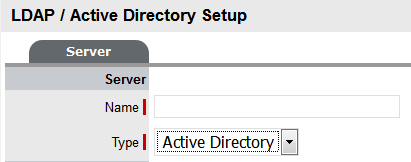
-
Define all the Domains from which Users will be authenticated
Domains will need to be entered in both NT and Windows 2000 domain naming systems formats. This is because Active Directory conforms to Microsoft™, Windows NT and Windows 2000 authentication protocols.
Make entries with care, as they are not validated against the Directory Server by the system Domain Editor.
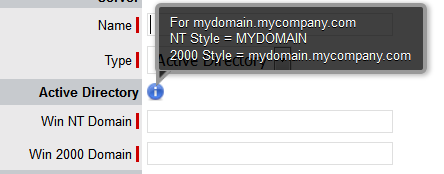
-
Here is an example of both the naming conventions for the domain:
-
mydomain.mycompany.com
-
NT Style = MYDOMAIN
-
2K Style = mydomain.mycompany.com
-
-
Enables Import Groups, if you have configured Store and want to assign store items to an LDAP group using "LDAP Group Extension". To import LDAP Groups, select Import Groups and specify Group Admin DN, Password and Group Node/Base DN.
-
Click Save
-
Using the drop-down arrow, select the Default Domain, which is used in the following three ways:
-
on the login page
-
to authenticate against, when synchronizing with the Directory Server
-
where the system expects to find the User Groups.
-
-
Enter all other required fields to configure the Directory Server
Settings
Description
Security
Determines how the integration layer will authenticate. For Active Directory this should be set to Cleartext– Username + Password. Anonymous connections to Active Directory are rarely enabled.
Server Host
Enter the hostname or IP address of the Active Directory Server. On a Windows NT domain this will be the primary domain controller.
Server Port
The default Active Directory Server Port is 389. This is rarely changed.
Username
Used by the system to authenticate against the Active Directory Server when reading account information. The domain prefix/suffix will be appended, based on the default domain, when connecting to the Server.
Password
Enter the Password for the Username account.
Users Node
The component of the base domain name that refers to the location of the User Groups .For example, if the location of the User Groups is the following:
ou=UserGroups, ou=MIS, dc=myoffice, dc=mycompany, dc=com (SeeLDAP/Active Directory Advanced Settings for information on Group configuration.)
Groups must be in the default domain, in this case myoffice.mycompany.com. The Users Node only needs the location of the Groups within the default domain, so the Users Node in this example will be: ou=UserGroups, ou=MIS.
Group Admin Details
Group Admin DN: Specify the group admin DN.
Example: cn=user, cn=users, dc=domain, dc=com
Password: Specify the password of the DN.
Group Node/Group Based DN: If this field is not specified, then it considers the value specified in Users Node/Base DN.
NOTE:The above options are enabled only when you select Import Groups checkbox in the Groups section. This is used to assign a store item to an imported LDAP Group using the LDAP Group Extension.
Locale
Default Timezone
Select the default Timezone to be applied to all User accounts imported via Active Directory.
-
Click Save.
Repeat the above process to add more than one authentication server for authorizing User access.
Test Button

The Test button creates a connection to the Active Directory Server, applying the configuration settings. If successful, it will attempt to determine how many Users are in each group and display a Results Screen.
NOTE:If the test fails, an error message will display the cause.
Sync Button

The Sync button runs the synchronization process to import all Users from the Server Directory. If new Active Directory Accounts have been created and those Users require immediate access to the system, a manual synchronization would be used.
Only one synchronization can run at a time. When multiple Users need access, create the accounts, then run a single manual synchronization.
A manual synchronization may take some time as it depends on the connection speed with the external service. The manual synchronization works best for small directories. Larger Active Directory implementations can take some time to propagate the changes, so account information may not be immediately available.
Importing Customers
Customer details can be imported using Active Directory by enabling the option, if required. When the system is setup to synchronize with Active Directory, move to the Setup>Privileges>Customer tab and enable the Include Customers option.

If there is a need to create Customers using Active Directory and the system's internal authentication capability, Mixed Mode authentication can also be enabled. After the option to Include Customers is set to Yes in the Customer Privilege tab, the Mixed Mode field is displayed. Set this option to Yes to allow Customers to be created directly in the system and using Active Directory.
Imported Account Usernames
Accounts imported from Active Directory use the UPN as the Username, as opposed to the NT style login. The domain component of the UPN is derived from the selected domain in the popup on the login page, which means Users need to enter their login name only to connect to the support application.
Login details are passed directly to the directory server for authentication and are not retained within the service management system.
LDAP/Active Directory Advanced Settings
LDAP/Active Directory Advanced Settings
Before setting up the LDAP/ADS configuration within the system, the Advanced settings should be revised. The default setup assumes that the User Groups that the system uses to authenticate match what is on the server, and that the User information imported matches the attributes available on the server.
LDAP/Active Directory Advanced Options Set-up
To configure the Advanced options within the LDAP/Active Directoy Setup window:
-
Select Setup>Authentication
The LDAP /Active Directory Setup screen appears.
-
Click Edit
-
Move to the Advanced tab of the selected Authentication Server
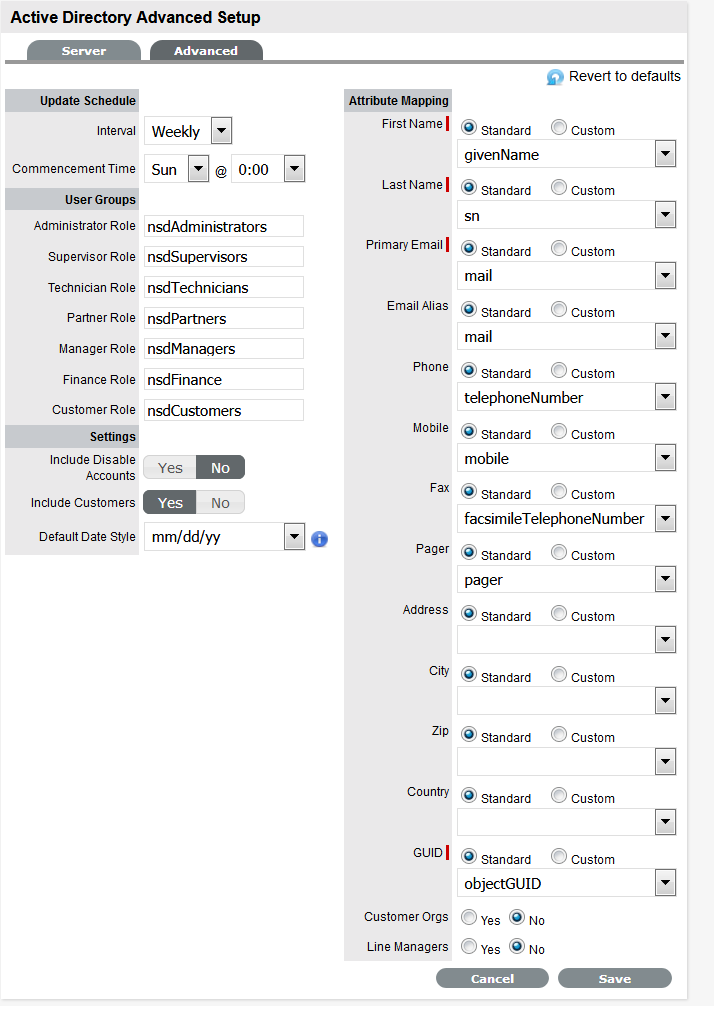
-
Enter the relevant details for the fields, as required
Field
Description
Revert to Defaults
Resets the installation defaults.
Update Schedule
Sets a routine synchronization to update the system with current AD/LDAP accounts. Select the required Daily, Weekly or Monthly intervals and Commencement details.
Commencement Time
Set the day of the week and time the system is to start automatically synchronizing with the directory server.
User Groups
Provides imported Users Roles. (The system will look for these groups by default)
The User Group names can be customized, only requiring a unique name for each group. The group names on the Directory Server must be identical to the User Group names entered here. Customize or use the default User Group names as necessary.
Members of each group will be assigned the appropriate Role within the system. To assign multiple Roles to a User, make sure they are members of each of the required groups. Users can have only one of the Supervisor, Technician or Partner Roles but they can also have any other Role or combination of Roles.
Attribute Mapping
Maps attributes from the directory server to corresponding fields in the system. Native system fields are First Name, Last Name, Email (A unique Email Address must be included for a User account to be created), Phone, Mobile, Pager, Address, City, Zip and Country.
NOTE:Mandatory User information for new and existing User accounts include the First Name, Last Name and Email address. If these details are not available, the application will not validate an existing User account and automatically reassign any open or active requests to another valid User.
Standard:Next to each field is a drop-down menu containing the list of default fields specific to either LDAP or ActiveDirectory server type. For each native name, the default fields are selected. Use the default mapping or select the mapping attribute as required.
Custom: Select the Custom option to manually enter an Attribute Field.
GUID
Global Unique Identifier
For ADS select objectGUID
For OpenLDAP select entryUUID
For eDirectory select GUID.
LDAP User fields/ Mixed Mode User Fields
The LDAP User field headings will be replaced with any custom LDAP/ADS Accounts fields created by the Administrator in Setup>Custom Fields ( See Custom Fields.), or Mixed Mode User Fields if the Mixed Mode option is enabled in the Server tab.
Use the drop-down list to select the appropriate mapping to the matching directory server field or select Custom to manually enter a Field.
Customer Orgs
Organizational Unit relationships can also be mapped from the authentication server. By default this is not enabled. To activate Customer Organizational Unit mapping, select Yes for the Import Customer Organizational Units option and define where the Company and Department information is to be derived.
Line Managers
LDAP attribute that defines a Customer's line manager, which is used for processing approvals on Service and Change Requests. Only system users with the Customer Role can be assigned as Line Managers.
-
Click Save.
Mapping Fields to the Matching Directory Server Field
The LDAP User field headings will be replaced with any custom LDAP/ADS fields created by the Administrator in Setup>Custom Fields. See Custom Fields. Use the drop-down list to select the appropriate mapping to the matching directory server field or select Custom to manually enter a Field.
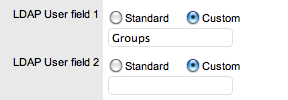
User details are imported when synchronization with the Active Directory/LDAP server takes place. Imported fields cannot be modified through the service management tool directly, the appropriate authentication server console must be used.
Import Customer Org Units
Organizational Unit relationships can also be mapped from the authentication server. By default this is not enabled. To activate Customer Organizational Unit mapping, select Yes for the Import Customer Organizational Units option.
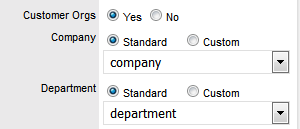
NOTE:The details of the Org. Units are not populated upon this synch, only the Org. Unit names.
For the Org. Unit details to be assigned to Customer or User Information, create the Org. Unit in the Supervisor>User>Organizational Units tab and ensure the Org. Unit name is identical to what is stored in the authentication server. If the details are not identical, the system will create another Org. Unit.
Billing
The Billing module allows Users to create Invoices, Purchase Orders and manage Customer support Contracts. Billing allows support organizations to charge Customers for support services provided, and manage Items purchased with Service Contracts.
When the Billing module is enabled by the system administrator, the Invoices and Purchase Orders sub-menu options are available within the application Finance tab. Purchase orders can simplify the tracking of where and when new Items are purchased or leased. This feature is not meant to replace an organization's original PO system, it is designed to easily link a specific PO number (and its associated vendor and date information) with an Item.
The Invoices section allows Customers to be billed for products (Items) or support services (Contracts) provided by the organization. An Invoice can be created when an Item and Service Contract is ordered by a Customer. Alternatively, Invoices can be created for Service Contracts alone, as the Item may already exist in the system.
Invoices can be generated through the following screens:
-
Within the Invoices section
-
When a request is created against an out-of-contract Item
-
When an Item, Customer or Organizational Unit is created, or edited to assign a new SLA.
The Billing options include:
-
Billing
Description
Purchase Orders
Allow Users to track Items from the moment an order is placed to its delivery and implementation. POs cover leased and purchased Items.
Contracts
Within Contracts, Users can manage Customer Service agreements over a specific time period.
Invoices
Allow Users to charge Customers for contracts. When Invoices are activated, Contracts are automatically enabled
Display SLA Prices
Enables SLA Price fields to be visible in the SLA Editor screen. This allows the Supervisor to allocate costs to SLAs and assists with the calculation of Break Even Point costs for Service Items.
See: SLAs.
Email Notifications
(This option is visible when Contracts are enabled.)
Enables the system to update Finance Users via automated emails, regarding Invoice and/or Contract related matters.
Global Settings
Currency
Defines the currency that is to be automatically applied by the system for all financial transactions.
NOTE:Invoices and Contracts will not work when Global Items are in use. If Billing is enabled after the application has been in use, a Supervisor will need to assign owners to Global Items before Billing can be activated.
Purchase Orders
Purchase Orders
Purchase Orders can simplify the tracking of where and when new Items are purchased or leased. This feature is not meant to replace an organization's original PO system, it is designed to easily link a specific PO number (and its associated vendor and date information) with an Item.
Enabling Purchase Orders
To enable Purchase Orders:
-
Select Setup>Billing
-
Set the option Enable Purchase Orders to Yes

-
Set the default tax rate
The percentage amount entered here is applied by default to all POs.
-
Enter the Company Details to be used on the PO
-
In Global Settings, select the preferred currency
-
Click Save.
NOTE:A logo can be applied to system generated POs by adding the graphic within the Setup>Customize tab. (This option is only displayed when the Purchase Orders functionality is enabled within the Setup>Billing tab.)
The Purchase Order sub-menu option is made available within the Finance tab for Finance, Supervisor and Technician Users, when enabled.
Contracts
A Contract is made up of a Service Level Agreement (SLA) and a Service Delivery Period (start and end time). They can be used to manage an entitlement to service from a start date, through to an end date.
Contracts and Invoices are used together when the Service Desk needs to charge its Customers for any support provided. Billing within the system is on a per Contract basis, and is enabled automatically when Invoices are activated.
Contracts can be created for different elements to suit organizational needs. Contracts can cover the individual elements:
-
Items
-
Customers
-
Organizational Units
-
Requests
Pending Contracts are contracts that have a start date set in the future. They automatically become active on the contract start date or can be enabled manually.
Enabling Contracts
To enable a Contract:
-
Select Setup>Billing
-
Click Yes to enable Contracts
A Contracts tab will be visible.
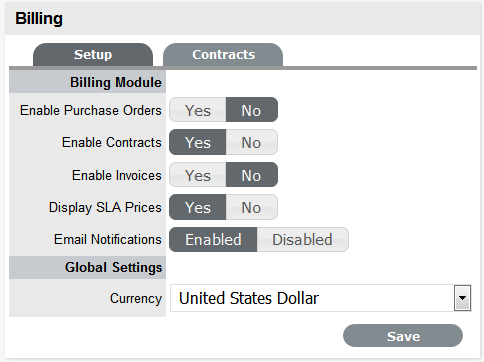
-
Define the Email Notifications option for Finance Users
When enabled, automated emails are sent to Finance Users regarding matters relating to POs, Invoices and/or Contracts.
-
Set the Currency for all financial transactions managed by the system
-
Move to the Contracts tab to define parameters for Contracts
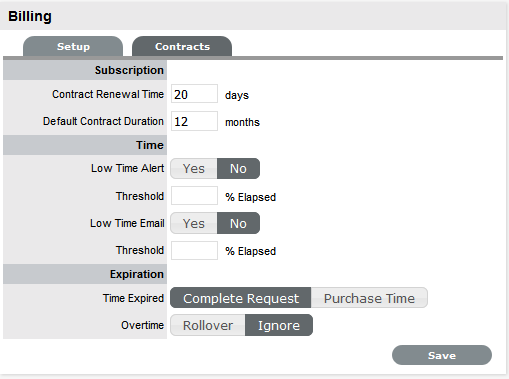
Options
Description
Subscription
Contract Renewal Time
The system can automatically send a Contract Renewal Invoice before a contract expires. Enter the number of days prior to the contract expiration date for the system to send the renewal invoice.
For Contracts not to be automatically created, leave this field blank.
(The information for the invoice can be configured in the InvoiceSummary link within the Setup>Email>Templates>Email Summary Templates filter screen. This template is sent with the InvoicePrefix email that can be edited in Setup>Email>Templates>Full Email Templates list. )
Default Contract Duration
The system sets the default contract renewal period to 12 months, adjust or delete the entry as required.
Time
Low Time Alert
The system can automatically create an alert within the Customer Portal for customers that have Time-based contracts (i.e., purchased a quantity of support hours.) The Alert can be sent based on the percentage of hours that have been used.
Low Time Email
The system can automatically send an email to a Customer that is getting close to using all their support hours in their Time-based contracts. The Email can be sent based on the percentage of hours that have been used.
The Email content is set in the ContractTimeLow option of Setup>Email>Templates.
Expiration
Time Expired
When a Customer's contract is expired when a User is working on a request, this option specifies if the User can Complete the request although the Contract has expired and if the system will lock out the User until the Customer has purchased additional time.
When Complete Request is selected, the following options are displayed:
-
Rollover - means the time used to resolve the issue will be subtracted from the Customer's renewed contract.
-
Ignore - means the time used to resolve the issue, although the Customer contract has expired, is not allocated to a future contract.
(The subject line and content for the automated emails sent on contract expiration is configured in the ContractTimeElapsed and ContractTimeElapsed of Setup>Email>Templates.)
-
-
Enter the Contract Renewal Time, if required
For contracts not to be automatically created, leave this field blank.
-
Set Notifications and Thresholds
-
Set Time Expired option

-
Click Save.
1.2.3 Configuration Steps
These configuration steps are recommended as a guide to assist with customizing the application to suit the service environment. These steps are what is required at a minimum to enable your system. It should be noted that these steps require access to the Administrator and Supervisor views.
The following procedure covers editing the logged in User account details and ensuring this User has all the relevant privileges to achieve what is required to configure the system. It then details the steps to enable the system to work with Email, setting the privileges for how Customers and Technicians can interact with the system, and how requests and the system will behave. This is defined within the Setup>Privileges tabs.
The User then has the option to customize the look and feel of the system, although this can be done later, if preferred. The next step is to create Customers and Users in the system.
Moving to the Supervisor Role, the User then configures the day-to-day elements within the application, which are part of creating and managing requests. This includes setting the timeframes for managing requests and defining trigger points for escalations by configuring SLAs; detailing the steps a request will move through, by customizing Workflows, which includes setting the stages of the Workflow where timers will trigger automatic warnings and escalations; defining the Team(s) of Technicians who will be associated with the customized Workflows and SLAs.
With the basic elements in the system now in place, the User then moves to the Configuration tab to customize the Configuration Management Database (CMDB). This part is often considered the most complex part of configuring the system, as this is where the service environment, including physical and service Items, is mapped into the system with associated relationships. When designing the CMDB, first the templates for all the different Item Categories are created. These are refined as Item Type templates, with these two templates used to define the information recorded against each Item and classification of issues that can be associated with each Item when requests are logged by Customers.
After the CMDB structure is defined, Items are imported via AMIE or .csv file. This is when the Items are associated with Customers or Organizational Units, who can log requests against the assigned Items.
In the Administrator (Setup) view:
-
Customize the default Supervisor access
Include Incident, Service Level Management and if applicable, Request Fulfillment, Problem and Change Management. Adjust the User Timezone, if applicable. (See: User)
-
Configure Email Setup and Email Messages (See:Setup>Email)
This step allows the system to manage requests via email. After completing the information in the Server and Setup tabs, the content for automated emails sent by this system can be customized. This does not have to be all done at this point, however, it is suggested that within the last page of the Templates tab, the Signature be updated to reflect the service organization name.
-
Enable System Privileges (See: Setup>Privileges)
At this stage, it is suggested that each option be reviewed in theUser, Customer,Request and System tabs within the Privileges sub-menu option. Although it should be noted, these can be adjusted in the future. If you are unsure about what an option refers to, select the Help button on the system UI, to display the relevant page of the User Guide. Be sure to set the appropriate Time Zone within the Customers Privilege tab, as this needs to be set before importing Customers and Users via an authentication server to ensure it is set correctly on all newly created accounts.
-
Customize Banners and Welcome Page Message (See:Setup>Customize)
This can be done now if the images are available. Alternatively, return to this step at a later stage.
-
Create Customers and Users, which include Supervisor, Technician and Partner accounts
Note, to associate Organizational Unit information with Customers or Users, this can be configured at this point within the Supervisor>User>Organizational Unit tab. Should the import include the name of the Org Unit that matches what is recorded in the system, the details from the information recorded internally will be applied to the Customer or User.
If using an authentication server, move to the Setup>Authentication tab.(See:Setup>Authentication;Active Directory Integration or LDAP Integration)
If creating accounts directly in the system (i.e., using internal authentication), go to the User tab. (See: Customers and Users.)
-
Set up Service Level Agreements (See: Service Level Management)
Move to the Supervisor view by clicking the User link, next to the logged in User Name.
If these are unknown at this time, the system includes a default SLA that can be used.
-
If applicable, create Operational Level Agreements and/or Underpinning Contracts (See: OLAs or UCs)
This is more than likely an advanced system configuration step at this point, or may not be relevant to the service organization. However, if OLAs or UCs are in place in the service organization, they can be mapped into the system now. Alternatively, they may be added later.
-
Customize or create Workflows (See: Incident & Problem Workflows and Service Request & Change Workflows)
The system includes default Workflows across all Processes. At this point, the default Workflows may be sufficient, or they can be customized to suit the service organization requirements. Alternatively, new Workflows can be created from scratch.
-
Create Teams (See: Teams)
By default the system includes one Process Team and the Unknown Team. Edit the existing Process Team, including defining the way it works, assigning the relevant Technicians, associating the Workflows that the Team will support, and setting the Technicians to work in the appropriate Escalation Layer(s). Teams are to be created for all Processes that are to be managed by the system (i.e., Incident, Problem, Change, Service Request.), although it may be relevant to finish one Process first, and return to do the other Processes at a later date.
-
Assign Default Teams and SLAs within Request Privileges (See: Setup>Privileges>Requests)
Move to Adminstrator view by clicking the Setup link, next to the logged in User Name
These settings will be applied to all newly created Items and Item Types that result from an AMIE import.
-
Configure the CMDB, by first customizing Configuration Categories:
Return to the Supervisor view by clicking the User link, next to the logged in User Name.
The system includes a number of default Categories, which should be more than enough for most organizations. Within the Category, the attributes of an Item that are to be recorded in the system, are defined by customizing the field labels. The stages that an Item can move through in its lifecycle are defined within the Life Cycle tab (i.e., Installed>Pending Configuration>Pending Test,etc). The types of issues reported against an Item are then created in the Classifications tab.
Configure the Category Details Fields (See: Configuration Categories)
Define the Category's Life Cycle (See: Category Life Cycle)
Create Category Classifications (See: Category Classifications)
-
Create Service Type templates and Service Items
For service organizations wanting to fast-track the capability to manage requests in the system, it is advised to create Service Items in theService Catalog to allow Customers and Technicians to log and manage requests within the application. Create a Type using the Service Category for each Service being offered, then create the Service Item with the newly created Type template. For the Service to be available in the Catalog, be sure the Service Item status is set to an Active, non Pre-production State. If the Customers are to access a Service on the Customer Portal, the Service Item Lifecycle State should also be set to Customer Visible.
-
Create Item Types (See:Item Types)
If the Types are not to be automatically created as part of an AMIE or .csv import, this is done in the Configuration>Types tab. This is where the Category template is associated with the Type template, the default Teams and SLA are set, and the Classifications for issues reported against Items are refined.
If Items are to be imported via a .csv file or AMIE proceed to Step 14.
-
Within the Admin>Setup tab, complete the Item Import (See: AMIE Import or CSV Import).
After the Items are successfully imported, a Supervisor User will need to refine the Type templates created as part of the import, if the default settings do not apply to a newly created Item Type. This task does not need to be completed immediately, and can be done on an ad hoc basis (i.e., whenever a Type template is opened in Edit mode, before saving, the system will prompt the User to set any required information.)
-
Within the Supervisor>Configuration tab, create Items. (See: Items)
If Items are to be created directly within the system, this is completed in the Configuration>Items tab. An Item Type template is selected for the new Item, which applies all the default information set within the Categories and Types tabs, then ownership of the Item is assigned to the new Item. Ownership can be Everyone (i.e., a Global Item), one or more specific Customers or Organizational Units. The specific attributes of the Item are recorded in the Details tab, and any relationships with other Items in the system can be created within the Relationships tab, now or at some point in the future.
Items can be mapped to Services, if required. (See: Service Catalog.)
Implementing the Processes
For information and steps for implementing for the following Processes, refer to:
1.2.4 Setup
Setup
The Email Setup tab allows the Administrator to define the behavior of the email polling functionality.
To set the email functionality details:
-
Select Setup >Email > Setup
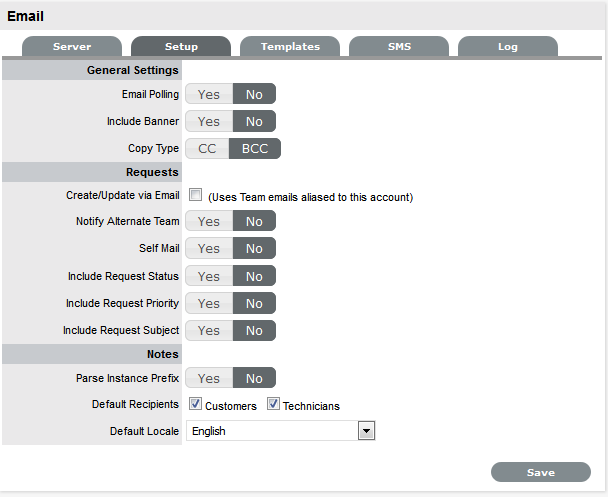
-
Define the settings in line with your organizational requirements:
General Settings
Email Polling
Enable Email Polling to allow the application to check for new email received in the mailbox on the incoming server defined within the Server tab.
For new messages that are received, the system will send a message to the sender acknowledging their message. System generated messages are customized within the Setup>Email>Templates tab.
NOTE:This option will be locked down if the Create via Email option is selected.
Interval
Enter the time period the system will use to check the incoming server for any messages sent to the support system.
Include Banner
Select Yes to include a banner within emails sent from the system.
The banner will be derived from: Setup>Customize>Setup>Public Banner.
Email Errors
When enabled, details of any system errors occurring while the application is running will be sent to the development lab.
Copy Type
For emails sent within requests, define if the Technician is to be copied or blind copied the correspondence.
Requests
Create/Update via Email
Select this option to enable requests to be created from emails addressed to the support system and Team addresses aliased on the email server. (See: Email Polling.)
NOTE:Email Polling will be locked down to Yes when this option is selected and the Accept Anonymous option is displayed.
Accept Anonymous
When enabled, the system will create requests from emails received from email addresses that do not exist in the application's database. (Refer below for more information regarding this setting.)
Notify Alternate Team
When enabled, and if there is more than one Team created for a Process, within the Summary tab of a request the Alternate Team field is displayed. Members of the Alternate Team will be notified relative to the settings defined for the Current Team, and for New Notes, if Technicians is selected in the New Notes screen.
Self Mail
When set to Yes, new Notes created by a Technician or Customer are also sent to them when they save the Note.
Include Request Status
When enabled, the system will include the request Status within the Email Subject line of any correspondence sent from the system, regarding a request.
Include Request Priority
When enabled, the system will include the request Priority within the Email Subject line of any correspondence sent from the system, regarding a request.
Include Request Subject
When enabled, the system will include the content from the Subject line of a request within the Email Subject line of any correspondence sent from the system, regarding a request.
Notes
Parse Instance Prefix
The Instance prefix is used to process email correspondence from multiple instances. If this is not required, set the option to No.
Default Recipients
Within the new Notes editor of requests, the default email settings can be defined for the recipient groups. Define the groups who are more likely to be sent every New Note created related to a request.
Default Locale
Set the default language file to be used for email correspondence. The option set is applied to the Email Locale field in the Customer and User Information screens and can adjusted on a per account basis, as required.
NOTE:The content for automated emails sent from the system for languages other than English, is defined within the Localization>Content tab.
-
Click Save.
Receiving emails from anonymous email addresses
When the Accept Anonymous option is enabled, the system will create requests from emails received from email addresses not recorded in the application. This process is managed by the System User being assigned as the Customer, and the original sender being added to the email address list, in the Notify section.
It should be noted, that enabling this option increases the likelihood of spam emails being converted into unwanted requests in the system. Email administrators should ensure that spam filtering is performed prior to the request being received in the inbox polled by the application. It is not the function of the service management tool to monitor, parse or filter emails prior to the creation of records based on the contents of the target inbox.
System Privileges
The System Privileges screen allows an Administrator to control the following options:
-
Knowledge Base
-
Surveys
-
Forums
-
Chat
-
Outages
-
Other general settings
Enable System Privileges
To enable System Privileges:
-
Select Setup>Privileges>System
The System Privileges tab is displayed.
Customer Privileges
Description
Host Address
To be completed with details of the machine hosting the application, if required.
Edit Item Numbers
Allows users to edit the identification number of an Item.
Public Knowledge Base
Allows access to the Public Knowledge Base on the Login Page.
Public Surveys
Provides access to Public Surveys on the Login Page.
Public Alerts
Alerts with the visibility defined as "Everyone" will be made available on the Login Page.
Public Request
Passwords
When LDAP or Active Directory Authorization is not used internal authentication is used. To define the password type to be used by the system select:
Random: the system will generate a random string whenever a password is reset.
Email: The Users Email Address will be used as the password.
Manual: Allows the User to manually create a password.
Password Questions
Enables the ability to set security questions within the My Account screen for Customers and Users, which are referenced when resetting or re-sending login credentials.
Session Timeout
The number of minutes the system waits before terminating idle sessions.
NOTE:Ensure that the session timeout on the server hosting the application, is equal to or greater than the Timeout option defined in the System Privileges. For changing the timeout option on the server that is hosting the application, edit as follows:
-
For a standalone application: Edit the /<MFSD_server_installation_path>/Server/webapps/LiveTime/WEb-INF/web.xml file.
-
For an appliance: Edit the srv/tomcat6/webapps/LiveTime/WEB-INF/web.xml file.
Default Name Pattern
Select the order for names being displayed in the system, when the First and Last Name are shown together on a screen.
Outbound Web Services
When enabled, request Workflow States and Item Lifecycle States can be assigned a 'listener', which allows these details to be updated in external systems. (Refer to the Extend section of the LiveTime website for details on how to develop a listener.)
OpenID Provider
Enables the system to function as an OpenID Provider for User authentication across network resources, as the user authentication source.
The OpenIDProvider URL should be:
<PROTOCOL>://<SERVER>/LiveTime/WebObjects/LiveTime.woa/
wa/providerLookup
The Protocol should be set to http or https and the server details should include where the system is hosted.
OpenID Consumer
Enables the system to delegate authentication of Users and/or Customers to one or more OpenID Providers. OpenID Providers that are to be used as delegates are configured in the Setup>Authentication>Social tab.
Trust all SSL Connections
Enables the system to automatically trust certificate while integration with a 3rd party server such as Email, LDAP and ZENworks. By default (and recommended), Trust all SSL Certificates will be set to "No" and users have to manually trust the certificates.
Attachment Preview
Enables attachment preview of the supported files in the request detail page.
NOTE:
-
The preview might not be displayed immediately.
-
Sometimes Preview might not be generated even for the supported files.
Hide old pages
Hides placeholder pages of the older UI which has been re-designed.
Telemetry
Telemetry enables ZENworks to collect statistical data about your usage of Service Desk. This data will enable us to ensure that you have the best possible experience with Service Desk.
Telemetry is scheduled to run once a month.
If your Service Desk server does not have outward connectivity and you want to upload the data manually, then perform the following:
-
Copy the telemetry enc file from the following location:
-
Windows: \Program Files\ServiceDesk\LiveTime\Telemetry
-
Linux: /usr/local/ServiceDesk/LiveTime/Telemetry
-
Appliance: /LiveTime/Telemetry
-
-
Using any FTP client connect to productfeedback.microfocus.com with username: anonymous and password: blank (optionally use your email-id).
-
Upload the file to the stats/MFSDTelemetry folder.
Mandatory Product Data
Telemetry collects the following mandatory product data:
-
License type
-
Technician count
-
Customer count
-
ZENworks integration
-
Database type
-
Operating system
Gather Configuration Data
(Optional) This collects the list of categories and count.
Gather Feature Usage Data
(Optional) This collects the following feature usage data:
-
Quick call count
-
Request info and count
-
Process info and count
Forum Options
Use Forums
This option enables and disables all Forums within the system.
Default Sort Order
Sets the default Forum Topic sort order to either ascending or descending.
Public Forums
This option enables Public Forums to be viewed from the login page and does not require an account to view.
Outages Options
Planned Outages Page
A link to the Planned Outages page is displayed on the Login Screen. Outages can be set within Configuration Item properties to schedule when the item will be off-line.
NOTE:To display the Outages tile, Planned Outages Page and Outages Page should be set to Yes in Setup > Privileges > System | Outage Options.
The Outage will be displayed only when the Minimum Criticality for an Item Category is set to equal or higher criticality, and the Item must be deployed.
For Item, Criticality must be equal to or higher than the Item Category Minimum Criticality setting.
To view the Outages Offline, go to the “Item Category” and ensure that the Offline State and Customer Visible are set to Yes.
Outages Page
A link to the Outages Page is displayed on the Login Screen.
Minimum Criticality
Defines the Minimum Criticality required for Items to be displayed on the Outages pages.
Show Affected Relationships
Enables Item from the Outages page to show the Item's Relationships.
Show Affected Users
Allows Item owner's details to be displayed on the Outages page.
Show Inactive Items
Displays inactive Items on the Outages page.
An inactive Item is an Item that is currently not in use by the organization.
Show Change Requests
Allows Customers to view Change Requests related to Outages displayed in the Customer Portal.
Search Outages
Enables Outages to be searched using the Customer email addresses or Item number.
KBA Review Options
Review KBA
When enabled a Review date field is displayed in the KBA Information screen. The default number of days between reviewing KBAs should be set and the number of days before the review date for an Alert Reminder, should also be entered.
KBA Comment Options
Enable KBA Comments
Enables commenting on the KBAs.
KBA Comment Visibility
Using this field, you can enable the comment visibility to Customers and Technicians. Owner of KBA will always have comment visibility.
-
-
Click Yes to enable, or No to disable a Privilege option
-
Click Save.
NOTE:Note: All Outages options apply to Service Manager only.
Re-Index Button

The Re-Index button at the base of the System Privileges page is used to re-build the system index. If the search engine appears to be failing text searches, this process will re-create the index. The indexing rebuild runs as a background process.
The following content and attachments is re-indexed:
-
Knowledge Base
-
Forums
-
All requests
-
Items
User Privileges
Within the User tab, privileges for Users with the Technician and Partner Role can be configured by customizing the options within the Technicians options list. This also includes enabling functionality related to all User work hours and public holidays. Defaults can also be adjusted for Users across the Knowledge Management and Configuration Management processes.
Specific to Technician Users, the following privileges include the ability to:
-
Create new Customers
-
Create new Items
-
Reassign requests
-
Edit other Technicians' requests
-
Create, edit, publish and delete Knowledge Base Articles by default.
NOTE:Privileges assigned to the Technician Role are also applied to the Partner Role.
Enabling User Privileges
To configure User Privileges:
-
Select Setup>Privileges
The User tab is displayed.
User Privileges
Technicians
Create Customers
Allows Technicians to create Customer Accounts.
Reassign Requests
Allows Technicians to reassign requests to another Technician within the same Team. When disabled, requests can only be reassigned through Escalation or changing the status of the request by the Supervisor.
Duplicate Requests
Allows Technicians to copy requests to fast track request creation. Supervisors have this privilege by default.
Manual Request Time
Disables the timer that automatically monitors and records the time when a request is in Edit Mode.
NOTE:
-
This option is not available when Contracts are enabled in the Setup>Billing tab, as time worked on a request must be added to Notes manually by Users.
-
In the redesigned request page, the automatic time will not monitor and record the time when the request is in the Edit mode.
View All Requests
Allows Technicians to view all the requests, regardless of Team assignment, logged in the system for the Processes they are assigned.
It also allows Technicians to edit requests that are assigned to fellow Team members.
Update Closed Requests
Set to Yes to enable Technicians to add Notes to requests that are assigned a Workflow Exit State.
Search All Items
Within the Items tab of a request, the All Items option is displayed in the Find Item box for Technician Users, if this option is enabled.
Include Globals Default
By enabling this option, the "Include Global* Options" is ticked by default in the Find Item field, when a User is creating a request.
Subject Required
Allows technicians to enable or disable the subject field in the new end-user portal.
Subject Required
To make the completion of the Subject field mandatory for Users during the request creation process, set the option to Yes.
Technician Alerts
Allows Technicians to create system Alerts.
Work Hours
Define Work Hours
Allows the Technician's availability to be configured within the Users>Schedule tab. This ensures that Requests are only forwarded to the User during the Defined Work hours, unless there are no other Users available.
*If this option is enabled, the Users Work Hours must be defined for each User, otherwise the built-in technician assignment logic will be ignored and all new requests will be assigned to the Team Lead.
Scheduled Vacations
Allows leave to be scheduled for Users, within the Users>Schedule tab. This allows vacations to be planned and automatically detected by the System when the User commences leave. The System will not assign the User new Requests when they are on vacation.
Vacation Reassign
This option becomes available when the 'Schedule Vacations' option is active. When enabled, this option ensures active requests of the User commencing leave are automatically re-assigned to available Technicians within the User's Team.
Login during Vacation
This option becomes available when the Schedule Vacations option is active. When enabled, users can login into Service Desk and work on requests during vacation. The System will not assign the User new Requests when they are on vacation..
Schedule by Technician
This option becomes available when the Schedule Vacations option is active. When enabled, users can login into Service Desk and work on requests during vacation. The System will not assign the User, new Requests when they are on vacation.
Observe Public Holidays
This option ensures the System gives consideration to public holidays when calculating SLA times, escalations and breaches.
NOTE:When enabled, the Public Holidays sub-menu option is visible within the Admin>Localization>Holidays tab.
Assignment Control
When enabled provides the Assignment option within the User Information screen. This allows a Supervisor or Administrator to turn request assignment off for a User who is available in the system.
Edit Customer Partner
Allows Customers to be assigned to Partners within the Customer Information tab.
Create Outage
Enables a Technician to create outages for Items.
Force Analysis
The system will propose relevant Solutions within the Analysis tab, during the request creation process.
Configuration
Roles
Set the default privileges for the User Roles' ability to create, edit and delete Item information in the CMDB.
If you change the default privileges, for an existing user the privileges will not be updated. Since, these settings are not system level settings. But when you create a user the default privileges are assigned.
Individual settings below user information section will determine the actual privileges for that user. If you want to change these settings for many users, use the Bulk edit feature.
Knowledge
Roles
Configure the default Knowledge Base authoring permissions for each User Role.
-
-
Click Yes to enable, or No to disable a Privilege option
-
Click Save.
Customer Privileges
Customer Privileges specify the options that are available to Customers within the Customer Portal.
Enabling Customer Privileges
To enable Customer Privileges:
-
Select Setup>Privileges>Customer
The Privileges screen is displayed.
Customer Privileges
Description
Create Account
Allows Customers to create their own account from the Login screen.
Default Web Access
Define the default setting for Web Access on newly created Customer Accounts.
Default Tab
Select the default tab for the customer. By default the selected option will be displayed in the Customer portal.
Generic Requests*
Define if Customers can view, create or edit Generic Requests in the Customer Portal.
Generic Request Type*
This option becomes visible when Generic Requests option is active. Define the type for generic request from Incident, Service Request or Change Request. For example, if your generic request type is set to Incidents, when you create a generic request, the request gets listed as incident in the User portal. Then the technician can include item details.
Incidents
Define if Customers can view, edit, create (create and view), create or edit Incidents in the Customer Portal.
Change Requests
Define if Customers can view, edit, create (create and view), create or edit Change Requests in the Customer Portal.
Service Requests
Define if Customers can view, edit, create (create and view), create or edit Service Requests in the Customer Portal.
Service Incidents
If the option to create Incidents in the Customer Portal is enabled, this can be refined by defining if Incidents can be logged against Service Items. If this option is disabled then Services are not displayed in the Category drop-down list during the Incident creation process.
Also, if a Customer attempts to log an Incident against a Service via email by including the Item# in the Subject line, and this option is disabled, the system will send an error message. The "NoServiceIncidentContent" error message can be customized in the Admin>Setup>Email>Templates>Error Message filter.
Default Request*
Define the default request type from Generic Request, Incident, Service Request, Change Request or Quick Call. The list shows if the options are enabled. For example, if Service Request option is turned off, then Service request option is not shown as an option.
Items
Define if Customers can view, create or edit their own Item details within the Customer Portal.
Show Only Active Items
Allows Customers to only view Items that are marked as Active in the system.
Show Subject Field
Displays the Subject field above the Description field in the Customer Portal.
Show Status Field*
Allows to hide or display the Item status in the Customer Portal.
Enable CC for Requests
Enables customers to add emails IDs as CC for requests.
Enable Search for CC
Enables auto suggestion of email IDs and names of existing users when customer start specifying the mail IDs in the CC field of a request.
Allow Re-open
Enables customers to reopen closed requests.
Reset SLA
This privilege will be enabled only when Allow Re-open is enabled. By enabling this privilege, SLA will be reset when customer reopens the request.
Allow Re-open
Enables customers to reopen closed requests.
Show Priority/Urgency
Enables customers to view and set the Priority/Urgency for their requests. Select "No" to hide Priority/Urgency in the customer portal.
Show Time Spent
Enables customers to view the time spent by a technician on a request note.
Item ID search*
Allows Customers to search by an Item's ID when creating a new request.
Force Search
When enabled, proposes solutions for Incidents based on the Item Type, Classification and Description provided.
Create Forum Topics*
Allows Customers to create a new Forum topic through the Customer Portal.
Display Room
Displays the Room for an Item when creating a request.
View Technician
Yes allows Customers to view the details of Technician assigned to their request in the Customer Portal.
Show All Services
Enables the Service Catalog link in the Services tab of the Customer Portal. This allows Customers to view and log requests against all Services offered by the support organization (i.e., request access to a service). Services listed here are not assigned an Exit Item Lifecycle State.
Show Service Targets
Displays the Response, Restoration and Resolution targets for the SLA assigned to the request in the Customer Portal.
Enable RSS*
When enabled, provides the RSS Requests Menu option in the Customer Portal.
Enable Titles
When enabled, displays the Titles Tab within the Setup, which can be customized. This list is then displayed in the Title field in the User and Customer Information screen. See Multi-Item Requests.
Enable Item Shadow
When enabled, if requests are logged against an Item on the Customer Portal, Technicians can amend the Item assigned to the request without the Customer seeing the change.
Customer Defined Contact
When enabled, this option allows the Customer to define their preferred method of contact in their Profile or My Account screen. Their preference applies when a Team has the Customer Notification option set to Customer Defined.
Items in Request
If you select Mandatory, then the Item, Item Type and Item Category fields are mandatory when creating a request.
If you select Optional, then the Item, Item Type and Item Category fields are optional when creating a request.
If you select Hide, then Item, Item Type and Item Category fields are not displayed while creating a request and request creation will be similar to creating a Generic Request in the Classic Customer portal.
NOTE:This privilege was known as Items Required in ZENworks Service Desk 8.0 and 8.1.
Items Required
If you select Yes, then the Item, Item Type and Item Category fields are mandatory when creating a request.
If you select No, then the creation of request will be similar to creation of Generic Request in Classic Customer Portal in ZENworks Service Desk 8.0 and prior versions.
Show Additional Information
Enables you to display additional details such as location Preferred contact type while creating requests.
Show Contact Details
When enabled, allows customers to provide contact details such as Location and Preferred Contact Type and view Line Manager while creating requests.
NOTE:This privilege was known as Show Additional Information in ZENworks Service Desk 8.0 and 8.1.
Default Date Style
Sets the default Date format to be used across the application.
Default Timezone
Sets the default time zone across the application. This can be overridden on a per User basis, by a User who sets their time zone for their log in account
LDAP/AD
(Visible when an LDAP/AD connection is configured.)
Include Customers
Set to Yes if the system is to import Customer details when synched with an LDAP/AD server.
Mixed Mode
Allows Customer accounts to be created directly through the system, as well as being imported via LDAP/AD.
View Shared Requests
(Request visibility options for the Customer Portal.)
By Ownership
Allows requests to be viewed by all Owners of the Item, when logged against a Shared or Global Item.
(See the table below for toggle option outcomes.)
By Org Unit
(This option is visible when the By Ownership is enabled.)
Allows requests to be viewed by all Customers of an Org Unit assigned to the Item, when logged against a Shared or Global Item.
-
Click Yes to enable, or No to disable a Privilege option
-
Click Save.
Setting the View Shared Requests options
When setting the visibility of requests logged against shared Items, refer to the table below to ensure the correct visibility option is configured for your organizational requirements:
|
By Ownership |
By Org Unit |
Shared Request Visibility |
|---|---|---|
|
No |
Only visible to the Customer who logged the request. |
|
|
Limited |
No |
Visible to the Customer who logged the request and other Owners in the same Org Unit, assigned to the Item. |
|
Limited |
Limited |
Visible to Customer who logged the request and members of Org Unit they belong to, if the Org Unit is also assigned to the Item. |
|
Limited |
Yes |
Requests visible to Owners within all Org Units assigned to the Item. |
|
Yes |
No |
Visible to Customer who logged the request and other assigned Owners. |
|
Yes |
Limited |
Visible to Customer who logged the request, other members of the Org Unit the Customer logging the request belongs to and other Owners assigned to the Item . |
|
Yes |
Yes |
Visible to everyone who share the Item assigned to the request. |
Requests Privileges
Requests Privileges allows the Administrator to control the functionality available for requests and set default requirements. These privileges are applied system-wide.
Enabling Requests Privileges
To enable Requests Privileges:
-
Select Setup>Privileges>Requests
The Requests Screen appears.
Request Options
Enable Escalation Control
Enables escalation to be enabled or disabled on a per request basis. This option is only available to Supervisor Users.
Queues
Allows Teams to use a holding bay for requests that are received via email or the Customer Portal. The Queues can be enabled within the Team Information screen, on a per Team basis.
Control Deployments via RFC
When enabled, Change Requests are automatically created from newly entered Deployments, and will require approval before work commences on the Deployment.
Control CMS via RFC
When enabled, changes made within the CMDB by a Technician will generate a Change Request requiring approval before the change is implemented.
Customer CMS via RFC
When enabled, Customers creating Items via the Customer Portal generate a Change Request that requires approval before the change is implemented in the CMDB.
Minimum Solution Relevance
Define the minimum degree of relevancy for content included in the Description field of a request, when the system automatically searches the Knowledge Base to propose solutions.
Enable Quick Calls
Enables the functionality that allows the Supervisor to profile Requests using Quick Call Templates. These can be used by other system Users when creating new requests.
Request Priority
(Derived/Selected)
Derived: Allows the system to derive the Priority based on Urgency and Impact of the request.
Selected: Allows you to manually select the Priority from the list.
You can still select Urgency and Impact, but Priority will not be derived from the selections.
NOTE:Applicable only on the request detail page.
Default Priority
**This option is displayed when the Incident Priority is set to Selected. The selection made from the drop-down menu, is automatically applied as the default Priority for newly created requests.
Handshaking
Enables notifications to be sent to a Customer using the Propose button within an Incident or Request, stating the Incident/Request will be closed if no reply is received from them within a set number of days.
NOTE:Note: The Solution button within an open Incident/Request is not accessible when the Handshaking facility is enabled.
When enabled, if Problems or Changes are closed, any related Incidents or Requests are moved to the Pending - Approval State not to the default Closed State.
Handshaking Close Action
Sets the system default number of days to lapse before an Incident or Request will close if the Customer does not respond to the handshake email notification. This can be adjusted on a per Org Unit basis.
NOTE:To allow Customers to re-open an Incident or Request using the link in the handshake email, the web server must be using Port 80.
Customer Additional Information Reminder
Sends reminder mails to customers to notify that additional information is requested by the technician.
When a technician requests for additional information from customer and customer fails to provide the required information with specified duration (Remind After Days), email reminders will be sent to the customer. If customer fails to provide the required information after a specified number of reminders (Remind Count), then a note will be added to the request. Depending on the Handshaking settings, the request will be processed further.
-
The content of the reminder email can be configured in the CustomerAdditionalInformationReminder and CustomerAdditionalInformationReminderSubject email templates. To configure the templates, go to Setup > Email > Templates tab.
-
The Handshaking setting is not applicable for Problem and Change requests.
Remind After Days
Define the number of days to lapse before sending reminder email to customer to provide additional information that is requested from the technician.
Remind Count
Define the number of reminder mail that should be sent to customers to provide additional information that is requested from the technician.
Approval Reminder
To automatically send Managers reminder emails regarding Requests requiring their approval, set this option to Yes. When Yes is selected, define the number of days to lapse before a reminder will be sent.
The content of the reminder email is drawn from the ApproveChange or ApproveServiceRequest template. These are configured within Setup>Email>Templates tab.
Default Notes Visibility
Sets the system default visibility of Notes, when added to requests. If it is expected that the majority of Notes are to be emailed to Customers, select Public.
Allow Unknown
When set to No and a User opens a request that is assigned the Unknown Service Item, the User will be prompted to update the Item before saving the request.
Archive Requests
When enabled, the number of days a request is closed before being removed from the List View and archived is to be set.
Requests that are archived are no longer included for searching. However, they can be still accessible for reporting purposes.
If you modify the date range or disable the setting, the archived request that are no longer eligible for archiving will get unarchived.
NOTE:Archiving is reversible. However, if the previous archive task is running, then archive options will be disabled until the current task is completed.
Default SLA
Is used as the Default SLA when a new request is created without an SLA defined for the Item, Customer or Org Unit.
Default Incident* Team (required if using AMIE)
Set the Default Incident Team, which is used for AMIE integration and also set as a default Support Team for Item Types.
Default Problem* Team (required if using AMIE)
Set the Default Problem Team, which is used for AMIE integration and also set as a default Support Team for Item Types.
Default Change* Team (required if using AMIE)
Set the Default Change Team, which is used for AMIE integration and also set as a default Support Team for Item Types.
Default Request Team* (required if using AMIE)
Set the Default Request Team, which is used for AMIE integration and also set as a default Support Team for Item Types.
Review Options
Review SLA
When enabled will display the Review date field in the Service Level Information screen. The default number of days between reviewing SLAs should be set and the number of days before the review date for an Alert Reminder, should also be entered.
Review RFC
When enabled the system will display a Review date in the RFC Information tab. The default number of days between reviewing RFCs should be set and the number of days before the review date for an Alert Reminder, should also be entered.
KBA Options
Control KBA via Request
When enabled, a Request is generated when the KBA is created, deleted or amended and can only be published to the KB by a User with publishing privileges.
Request Type
Specify the type of request to be generated when new or amended KB content is moved to a "Pending Publication" state.
(The options are based on the ownership of Change and Service Request licenses.)
Default SLA
Set the default SLA to be used for when requests are logged regarding updates in the knowledge base. Applying an SLA here, determines which workflow and team will receive the requests for approval, as with any other request logged in the system.
-
* To be set after Teams have been configured.
-
Click Yes to enable, or No to disable a Privilege option
-
Click Save
Customize
The Customize menu allows the Administrator to brand the application where system banners can be replaced with the appropriate organizational banners. Graphics included should be . PNG images. The Application Banner should be 200 x 60 pixels and all other banners should be 500 x 70 pixels.
Adding a Customized Banner
To add a customized banner:
-
Select Setup>Customize
Banner Type
Displayed
Application
Visible on the Log in page of the system.
User
Visible in the portals for Supervisor, Technician, Administrator, Partner, Finance and Manager Users
Public/Email
Displayed on public portals for Knowledge, Outages, Surveys and Forums. This banner is also included in emails when the Setup>Email>Setup option of Include Banner is set to Yes.
Customer
Visible in the Customer Portal.
NOTE:Banners for Partner Organizations can be uploaded in the Banners tab of the User>Partner Organization screen. This will override the system Customer Portal banner for Customers associated with the Partner Organization.
-
To use Custom Banners, select the Use Custom checkbox at the top of the Customize Banners screen

-
To upload a new banner, click New
A window with a browse function appears.

-
Browse to the location of the image and click

The image will be uploaded.
-
Repeat the process until all banners have been replaced
-
Click Save.
NOTE:When the Purchase Orders functionality is enabled within the Setup>Billing tab, the option to upload a logo that will be used for system generated POs is displayed. The graphic should be saved as 150x150 PNG file.
Portals Tab
All Public Access home page messages can be fully customized under the Portals tab. Links to documents and downloads may be added. The home page messages can be customized for:
-
Alerts
-
Forums
-
Knowledge Base
-
Login Page
-
Public Outages
-
Planned Outages
-
Surveys
-
Customer Portal welcome message
NOTE:Outage Home and Planned Home Messages apply in Service Manager only.
To customize a Public Access message:
-
Select Setup > Customize
-
Click the Portals tab
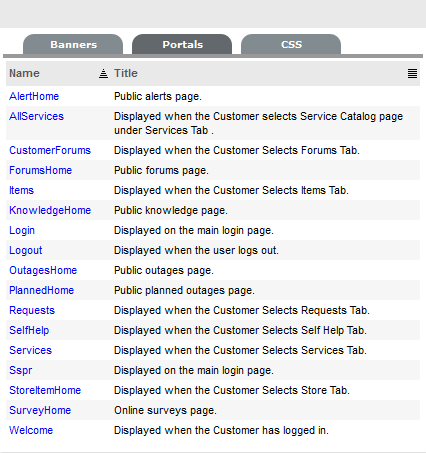
-
Select the Name hyperlink
The HTML editor appears.
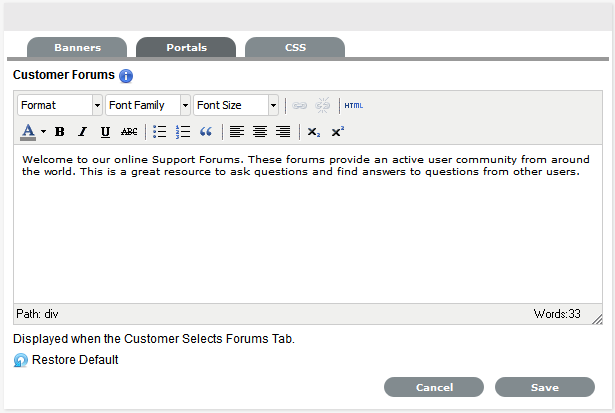
-
Edit the message as required
-
Click Save.
Cascading Style Sheets
The system can be further customized using cascading style sheets (CSSs) to amend:
-
Color
-
Fonts
-
Tabs
-
Graphics
See: CSS Tab.
Cascading Style Sheets (CSS)
Cascading Style Sheets (CSS)
The CSS tab allows Users to customize the look and feel of banner backgrounds and tabs within the system. Knowledge of working with cascading style sheets is recommended when making changes to these settings.
The options available for configuration include:
|
CSS Editor |
|
|---|---|
|
Application Banners |
|
|
div.login-panel div.login-header div.login-title-custom |
This controls the style of the customized banner on the Login page. |
|
div.login-panel div.login-header div.login-title-container |
This controls the style of the default banner on the Login page. |
|
div.login-panel div.login-header span.login-app-logo |
This controls the helpdesk icon graphic on the Login page. |
|
#header .customPngBanner |
This controls the style of the customized banner within the User portal. |
|
#header .defaultBanner |
This controls the style of the default banner graphic within the User portal. |
|
#header .customPngBanner |
This controls the style of the customized banner within the Customer & Public portals. |
|
#pageHeader .defaultBanner |
This controls the style of the default banner within the Customer & Public portals. |
|
Menu Options (User Portal) |
|
|
#menu a.active |
This controls the highlight on the active (main) menu selection. |
|
submenu a:hover |
This (in tandem with the span extension) controls the mouseover (hover) on the submenu tabs. |
|
#submenu a:hover span |
This (in tandem with the hover default above) controls the mouseover (hover) on the submenu tabs. |
|
#submenu a.active |
This controls the highlight applied to the selected submenu options. |
If unwanted changes are made to the system Style Sheets, use the Default button to return the system to the out-of-the-box format.
LDAP Authentication
There are several ways to authenticate users of the service management application. By default the system uses its internal authentication mechanism but there is also the option to authenticate against one or more Directory Servers or use OpenID Providers.
Internal Authentication
Using internal authentication requires the Administrator or Supervisor to create accounts for all User types by entering the contact information, access levels and password. This information is then saved to the system database. The typical case for using Internal Authentication is where there are few Users, or in an environment that has no pre-existing directory server. Usually, the Administrator would configure the User accounts prior to announcing the system is operational, and from that point on, maintain the accounts as necessary. (See: Create Customers or Create Users.)
OpenID Providers
OpenID is a decentralized process to verify a Customer's or User's online identity. It addresses the single sign-on issue by not relying on a centralized website to confirm a User's identity. The system can be enabled to be an OpenID consumer, which provides seamless authentication between third party authentication utilities and the service management system. OpenID Providers are configured within the Social tab, and Customers or Users that have accounts with the configured OpenID Providers can log into the system by selecting the relevant icon on the Login page.
Directory Server Authentication
The system allows the Administrator to connect to one or more Directory Servers for User authentication purposes. This removes the need to create User accounts as it allows the application to synchronize User accounts and access levels with the existing Directory Server. It has the added benefit of allowing the Administrator to work with existing infrastructure. (See: AD Authentication or LDAP Authentication.)
Directory Server Groups (External Authentication)
Roles are used to grant access within the application. Users must be assigned to Groups on the directory server that correspond to the Roles within the support system. Group members are assigned Roles and access levels within the service management tool.
The default group names the system expects to find on the directory server are:
-
Administrators
-
Supervisors
-
Technicians
-
Partners
-
Managers
-
Finance
-
Customers
The Group names can be customized in the LDAP/Active Directory Advanced tab. Users can belong to more than one group, for example if a User holds the Roles of Technician and Manager, they would belong to the Technicians and Managers groups.
NOTE:Users can have only one of the Partner, Supervisor and Technician Roles. Therefore, they can belong to only one of these groups. However, they may also belong to any other group, or combination of groups.
The following fields may or may not be mapped, depending on the options set by the system Administrator:
-
First Name
-
Last Name
-
Email
-
Phone
-
Mobile
-
Pager
-
Address
-
City
-
Zip
-
Country
Email Address
All User accounts must include an email address to be successfully imported into the system. If additional fields have been mapped from the authentication server to corresponding fields in the application, a drop-down menu containing all the optional values for the field will be available beside the mapped field. Choose the correct value from each list.
Mixed Mode Authentication
The application can use a combination of internal and external authentication. This means, the service management tool can be synchronized with a Directory Server to import User and Customer details as well as allowing Customer Accounts to be created directly within the system. Such a feature is useful, if the service and support solution is being used for internal and external customer support.
To enable Mixed Mode authentication, after the system has connected to the Directory Server, move to the Setup>Privileges>Customer tab and enable the Include Customers option to display the Mixed Mode field. Set the Mixed Mode option to Yes.
NOTE:If authenticating against a Directory Server, all User accounts will validate against the server except for the application default Administrator User. The default Administrator User account details can be modified within the My Account tab of the application.
Creating a Customer (Internal Authentication)
Creating a Customer (Internal Authentication)
Use the Customer Information Tab to view and edit Customer details. It is also possible to set Customer Roles, line managers and default login details.
Creating a Customer Account
When creating a Customer, the following four tabs are available:
-
Contact
-
Aliases
-
Items
-
Contracts
Information Tab
This tab is used to enter contact information for a Customer, when creating a new customer account.
NOTE:If Custom Fields are to be created for Customer Information it is recommended that the Administrator complete the configuration prior to creating Users. See Custom Fields.
To create a Customer account using internal system authentication:
-
Select User>Customers
-
Select New
-
The Customer Information screen appears, with the following fields:
Customer Information Fields
Access
Title
If enabled, select the appropriate title from the drop-down options. (This field is displayed if the Enable Titles option is set to Yes in the Admin>Setup>Setup>Privileges>Customer tab.)
First Name*
Customer's First Name.
Last Name*
Customer's Last Name.
User Name*
The login User name credentials for the User. If this is imported via LDAP or Active Directory, it can not be edited. Otherwise, enter a Username. Note that the value must be unique.
Password/ Confirm Password
The Default Password is set to the Customer's email address or a random string can be enabled by the Administrator in Setup>Privileges>System. See Authentication.
Customers can reset their password from the Customer Portal, or a Service Desk User can reset it in the customer account details using the Reset Password button through the Customer> Information tab.
Web Access
Web Access allows Customers to view their account information and Incidents via the Customer Portal.
Contact
Primary Email*
The Customer's Email address. System messages are sent to this address.
Send To
This field becomes when alternate email addresses are entered on the Aliases tab.
Select the most appropriate email address to be set as the default address applied to Customer correspondence. When the Send To field is set to an alias address, the Primary Email address is not included in the cc list, unless specified in the request Information tab cc list.
Org. Unit
The Organizational Unit, be it a Company or Department with which the Customer is associated.
(Organizational Units are created by the Supervisor, in Users >Organizational Units.)
Line Manager
If relevant, assign a system user with the Customer Role who can approve/reject requests made by this Customer, as part of the Change Management or Service Request approval process. (This information can not be edited if the line manager details are set by the LDAP synch.)
Room
This field is visible if the Display Rooms option is set to Yes in the Setup>Privileges>Customer screen and there are Room details configured in Organizational Units.
Address 1
First line of Customer's address.
Address 2
Second line of Customer's address.
City
Customer's city details
State
Customer's State details. Options will be displayed for the State, once the Country is selected, if Regions are configured for the Country in the system.
Zip/Postcode
Customer's area code.
Country
Customer's country. The country selected will determine the time zone and state options for the Customer.
Email Locale
Set the default language for email correspondence.
Phone
Enter Phone details.
Fax
Enter the Customer's fax number, if relevant.
Pager
Enter the Customer's pager details, if relevant.
Mobile
A mobile number can be entered as a contact number or for use with SMS (Short Mail Service message). An SMS can be sent to notify the assigned Technician when a request is created.
SMS Messaging options:
-
From the drop-down list, select the SMS Service Provider.
-
Override SMS Address. If your service provider does not appear in the list, click this checkbox and enter an alternate Service Provider.
SMS Override
Enter SMS Gateway override details for the Customer, if a number other than the one entered in the Mobile field is to be used to send/receive updates via SMS. Enter the complete SMS details in email address format, i.e., 000777891@smsgateway.provider.com.
Partner
Customer of
Nominate the Partner Organization associate with the Customer. This is an external service provider who manages the Customer's request.
(The option is enabled by the Administrator in Setup Privileges> Use >Edit Customer Partner. The Partner Organizations are defined by the Supervisor in the User>Partner Organizations tab.)
Locale
Time zone
The Customer automatically adopts the default Timezone set for the system. However, the Timezone can be manually adjusted here for the specific Customer.
Last Login
Auto-populated with the date the Customer last logged into the system.
Host
The IP address of the last login for the Customer
GPS
The GPS coordinates of the last known address for the Customer. (This field is displayed when the Record GPS option is enabled in Admin>Setup>Setup>Privileges>Customer tab.)
Roles
Current*
Multiple Roles can be assigned to a User. Select other Roles the Customer will use, by ticking the check boxes.
Note: If the Technician Role is selected, a Supervisor must be allocated.
Default Portal
The Default Portal is the user interface a Customer, who is assigned multiple Roles, accesses by default when they log into the system.
NOTE:If the Users Default Portal is set to Customer, the User details will not be accessible in the Users list, but included in the list within the User>Customer tab.
Details
Notes
Click on the field to enter any Customer relevant information.
-
* Denotes mandatory fields
-
Click Done.
Emailing Customers Credentials

To email a newly created Customer details regarding their system log in details, click the Email button within the Customer Information screen. If Random Passwords is enabled, selecting Email will reset the Password and forward the details to the Customer. If Password Questions is enabled in Setup>Privileges>System, selecting Email will send a link to the Customer directing them to a page that includes the security questions set for their account and reset the password based on the answers provided. Customers must complete this process within an hour of the email being sent.
vCard Button

Select this option to download and open the Customer's information in an electronic business card format, to email or save outside the system.
Aliases Tab
The Aliases tab is used to enter additional email addresses. Email addresses in the Aliases tab allow the Customer to send emails to the System or Team support addresses from more than one address. The system creates requests from these emails. Notifications for requests created using an address in the Aliases tab, are sent to the main email address and cc'd to the alias address that was used to create the request.
When one or more alias email addresses have been created for a Customer, a Send To field is displayed on the Customer Information screen, which allows the most appropriate email address to be set as the default address applied to Customer correspondence. When the Send To field is set to an alias address the Primary Email address is not included in the cc list, unless specified in the request Information tab cc list.

To add an alias email address:
-
Select User>Customers
-
Click on the Customer name
The Customer Information screen appears.
-
In the Information tab, click Edit
-
In the Aliases tab, click Add
-
Enter an alias email address
-
Click Save
-
Select Done.
When an alias email address has been created for a Customer, a Send To field is displayed on the Customer Information screen, which allows the alias email address to be set as the default address applied to Customer correspondence.
To remove an alias email address, in Edit mode, tick the checkbox next to the relevant email address and then click Remove.
Items Tab
The Items tab defaults to list of Items assigned to the Customer. To view Shared Items, tick the Include Shared option. To view the Item details, select the Item Number hyperlink. Select the Excel button to output the Item List to Excel format.
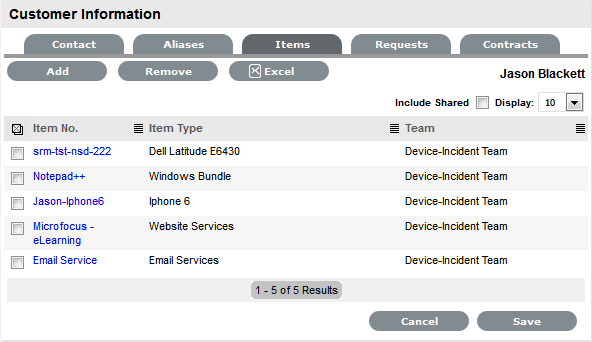
To add an Item:
-
Select User>Customers
-
Click on the Customer name
The Customer Information screen appears.
-
In the Information tab, click Edit
-
In the Item tab, click Add
The Find Item editor is displayed.
-
Search for the relevant Item
For details regarding an advanced Item search see: Advanced Search.
-
Select the Item # hyperlink
The selected Item will be associated with the Customer.
-
Click Save
-
Select Done.
To remove an Item, in Edit mode, tick the checkbox next to the relevant Item and then click Remove.
Contracts Tab
The Contracts tab displays a Customer's current contract status. A Customer can be assigned an SLA or Contract when Billing>Contracts is enabled. A Customer can only have one active Contract.

To create a new Contract for a Customer:
-
Select User>Customers
-
Select the Customer Name
-
Move to the Contracts tab
-
Click Edit
The system will display the Add button in the Customers tab
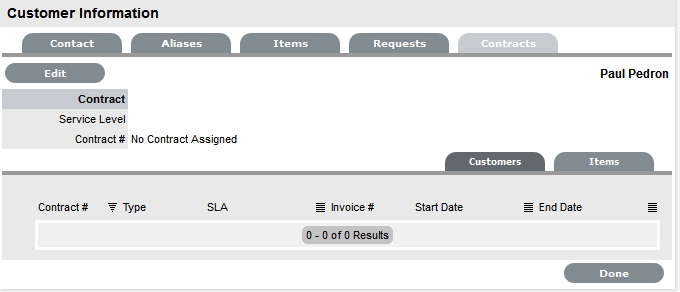
-
Click Add
The SLA options are displayed.
-
Select a Service Level from the list
When selected, the screen expands to display the Time, Start and End date fields.
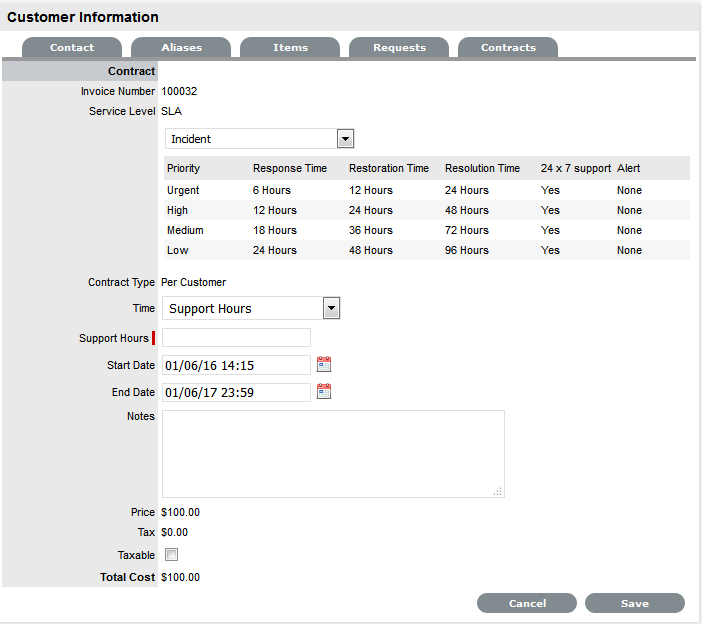
-
Define the Contract Time period
For the Per Customer Contract Type the Time Period for the Contract can be defined:
If Subscription is selected, the Start and End Dates are automatically completed by the system, but can be edited if required.
If Time Limited Subscription is selected, the Support Hours field is displayed and the number of support hours purchased by the Customer should be entered. Also, the Start Date and End Date fields should be completed manually, entering the length of time for the subscription period.
If Support Hours is selected, the number of support hours purchased by the Customers should be entered
If Support Hours By Month is selected, define the number of Support Hours covered per month and on which day of the month the Contract is designated as the Rollover Day. The Start Date and End Date fields are automatically completed as an annual contract subscription but can be edited, as required.
If the Start Date is set as a future date, the Pending Contract status is assigned. See Pending Contracts.
-
Click Save
-
Click Next to continue
The system reverts to the Contracts summary screen.
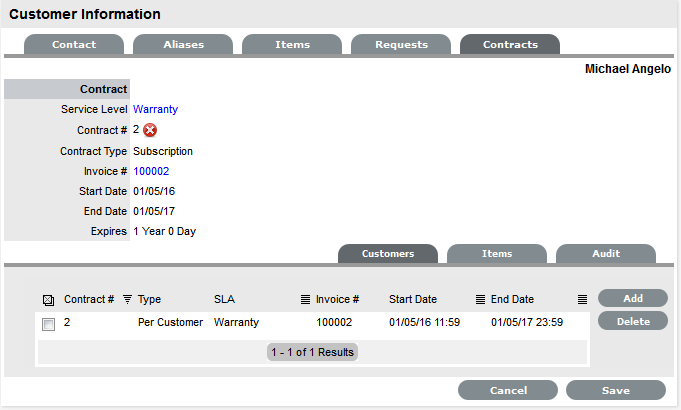
-
Click Save. Click Done.
To delete a current Contract select  next to the Contract Number. Alternatively, to delete a current or queued Contract, within the Contract>Customers tab check the field next to the relevant Contract # and select the Delete button.
next to the Contract Number. Alternatively, to delete a current or queued Contract, within the Contract>Customers tab check the field next to the relevant Contract # and select the Delete button.
The Items tab within the Customer>Contracts screen is used to list all the Items with a Contract that are owned by a Customer.
The list of requests with the time recorded against the Contract is displayed within the Audit tab. The Summary view displays the list of requests with total number of Notes and Time allocated to the Contract, while the Detail view includes a breakdown of all Notes and the associated time related to each request.v
Searching for Customers
To search for Customers within the Users>Customers tab:
-
Go to Users>Customer
-
Click

-
Enter any known Customer details
Or, for a complete Customer list enter a before or after date for Customer creation
-
Click Search
The results will be displayed in a table with the Customer Name and contact information.
-
Click on the Customer Name to open the Customer Information module or select the Email Address to send an email.
Re-enabling Deleted Accounts
Administrators have the ability to reactivate deleted Customer accounts.
To enable a deleted account:
-
Within the User > Customers tab select

-
Toggle the Account Status option to Deleted
-
Click Search
A list of deleted Customers is displayed.
-
Select a Customer to re-enable
The Customer information page appears.
-
Click the Enable button, to reactivate the account.
The Customer account becomes active and is available within the system.
LDAP Server Integration
Multiple types and sources of directory servers can be synchronized with the system at any one time. Among the several LDAP servers supported by the system, and which this section discusses, are the following:
-
Open LDAP
-
Netscape Directory Server
-
Novell eDirectory
It should, however, be noted that LDAP does follow a standard and as such the settings detailed herein should also apply to other implementations.
Configuring LDAP Server Integration
To configure LDAP Server integration:
-
Select Setup>LDAP
-
Click New
The LDAP /Active Directory Server tab is displayed.
-
Enter the Server Name
(If the system is to synch with Zenworks, ensure the Server Name matches the User Source Name used by Zenworks.)
-
Select LDAP within the Type drop down list
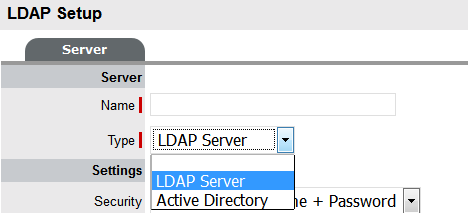
-
Complete the Settings fields
Fields
Description
Security
Secure Socket Layering (SSL) encryption is provided for Active Directory and LDAP server integration. Details entered here determines how the integration layer authenticates.
User authentication can be with Secure Socket Layering (SSL) or Clear Text. Select Anonymous or User name and Password.
If Anonymous is selected, ensure anonymous access to the directory is available.
Server Host
Enter the host name or IP Address of the LDAP Server.
Server Port
This is the LDAP Server Port. The default is 389.
User name
The system authenticates the user name against the LDAP Server. Leave this blank for anonymous connections.
Where a user name is provided, Netscape allows the internal users to connect as the account name, so using ‘cn=Directory Manager’ is acceptable.
Open LDAP expects the fully qualified Domain Name for the user, regardless of access level, so at the very least ‘cn=Manager,dc=example,dc=com’.
For other accounts the user BaseDN is required. Users logging in need only enter their login name, it is assumed the login name will be unique across the entire directory.
Password
If a User account is specified in the User name field, enter the account password.
BaseDN
The Base Domain Name refers to the domain location of the User Groups. For example, assume that the location of the User Groups is the following:
ou=UserGroups,ou=MIS,dc=myoffice,dc=mycompany,dc=com
The above String would be the BaseDN.
Locale
Default Timezone
Select the default Timezone to be applied to all User accounts imported using the authentication server.
-
Enter all required fields to configure the Directory Server
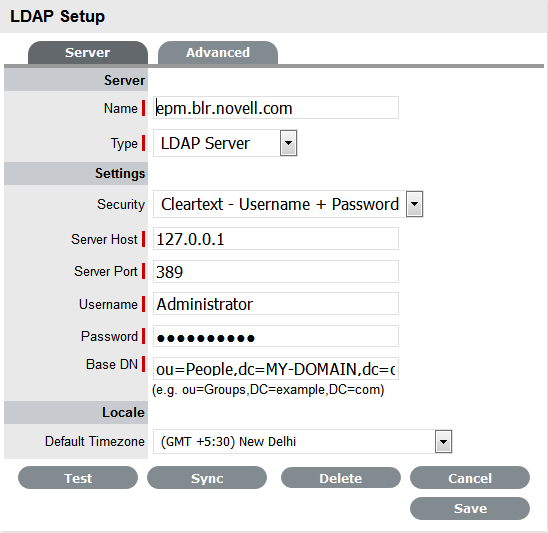
Test Button

The Test button will create a connection to the LDAP Server using the configuration settings. If successful, it will attempt to determine how many Users are in the top level of each group and display a Results screen.
NOTE:If the test fails, an error message will display the cause.
Synch Button

The Synchronization button runs the synchronization process manually. It is most useful for the initial deployment, and when new directory server accounts have been created for Users who require immediate access to the system.
If using Certificates ensure the certificate details are entered in the Certificates tab before synchronizing.
Only one synchronization can run at a time. For multiple users needing access, create the accounts on the LDAP server then run a single manual synchronization.
A manual synchronization may take some time as it depends on the connection speed with the external service. The manual synchronization works best for small directories, as larger directories take more time to propagate changes.
Importing Customer Details
Customer details can be imported using LDAP by enabling the option, if required. When the system is setup to synchronize with LDAP, move to the Setup>Privileges>Customer tab and enable the Include Customers option.

If there is a need to create Customers using LDAP and the system's internal authentication capability, Mixed Mode authentication can also be enabled. After the option to Include Customers is set to Yes in the Customer Privilege tab, the Mixed Mode field is displayed. Set this option to Yes to allow Customers to be created directly in the system and using LDAP.
Category Classifications
A list of Classifications used to define issues are created within this tab and used as the generic Classification for requests logged against Items that apply the Item Type Category being configured. The Classifications are also used by the system for proactive Incident analysis and Problem groups.
Supervisor Users can define additional Classifications for specific Item Types, within the Configuration>Categories>Item Categories>Classification tab.
The system is installed with several default Classification Type Categories, which can be edited if required.
NOTE:The General Classification is owned and used by the system and cannot be deleted. It is also advised that this Classification not be renamed, as this is the Classification assigned to requests when they are created via email.
Classification Tab
Additional Classifications can be created for each Item Category, while the system provided Classifications can be renamed or deleted. The Custom facility, when enabled, allows Users to add Classifications during the request creation process.
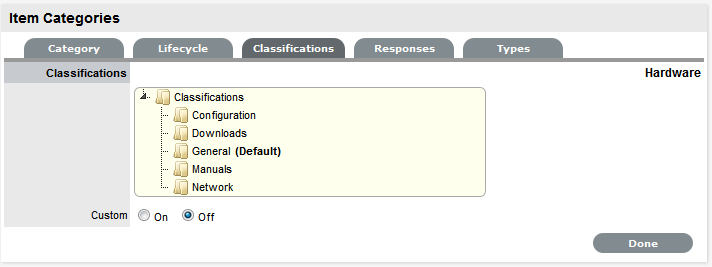
Creating a New Item Category Classification
To add a new Classification:
-
Select the Classification tab of an Item Category
-
Right-click on the Classifications header
-
Select Create
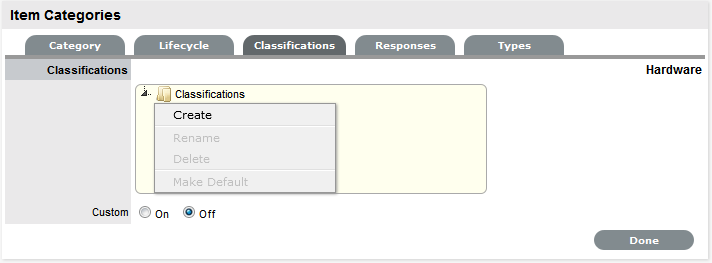
-
Enter the details in the newly created node
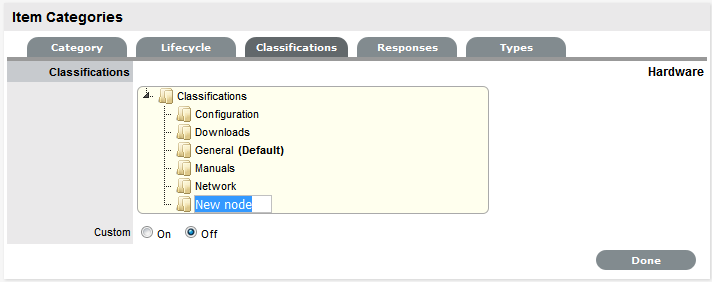
-
Click outside the text box to commit the entry listing

-
Repeat the above process to create all required list entries
-
Move an existing Classification to a new position, if required
Select the entry, then drag and drop the entry into its new location.
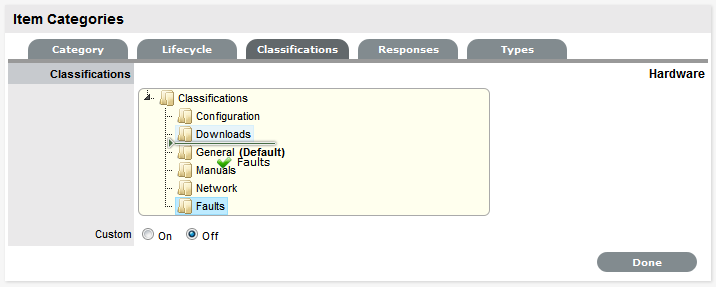
-
Click Save.
Creating Sub-Classifications
Classifications can be expanded to include nested Classifications.
To create Sub-Classifications:
-
Right-click the relevant Classification header
The Create, Rename, Delete and Make Default options are displayed.
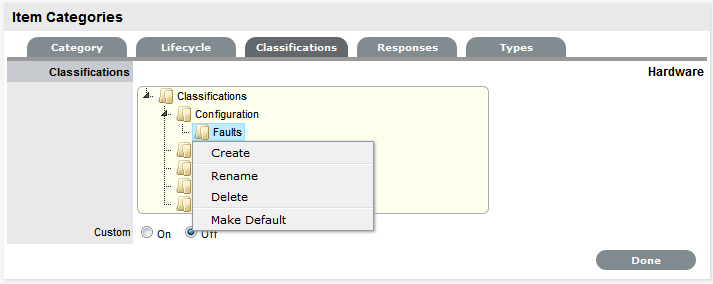
-
Select Create
A text box will appear under the Classification.
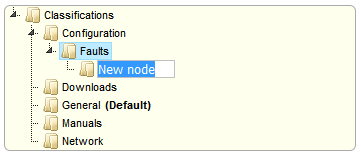
-
Enter the name for the list entry
-
Click away from the text box to commit and save the change
-
Move an existing Classification to a new position, if required
Select the entry, then drag and drop the entry into its new location
-
The above steps can be repeated until the sub-category list is completed.
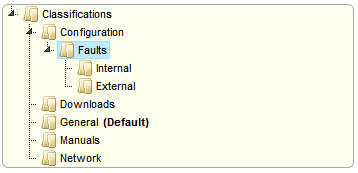
Renaming a Classification
Any Item Category classification can be renamed.
To rename a Classification:
-
Right-click the Classification
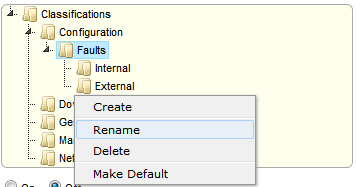
-
Click Rename
-
Edit the field content
-
Click away from the text field to save the change.
Deleting a Classification
To delete a Classification:
-
Right-click the relevant list entry
-
Click Delete
-
Click Done when the Classification Categories are complete.
Managing Items using Database Mapping (AMIE)
Within the CMDB Import screen multiple asset management datasources can be synchronized with the service management system. When one or more applications are configured within AMIE, a list is displayed within the AMIE Setup tab.
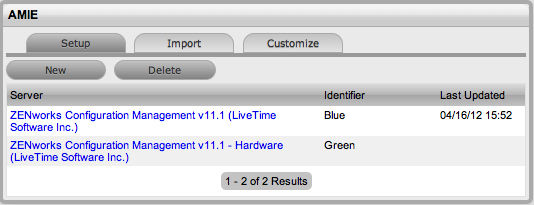
Importing Items Using Database Mapping
To import Items using Database Mapping, the following configuration steps need to be completed:
-
Select Setup>AMIE
-
Click New
The Server, Database, Ownership and Synchronization fields appear.
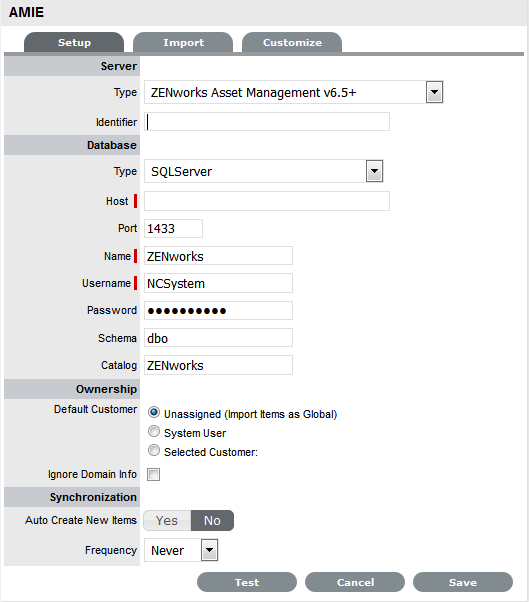
Configuration
System Type
Define the system type as Database Mapping.
Identifier
An identifying label that is used in List Views to inform Users regarding the Source of an Item.
Server
Type
Select the Type of inventory management product.
Database
Type
Select the Database Type.
Host
Enter the Host name or IP Address.
Port
Enter the Port Number for the database server.
Name
Enter the Database name.
Username
Complete User name details.
Password
Complete Password details.
Schema
Enter the Schema type.
Catalog
Enter the Catalog name. Typically this would be the name of the Database.
Notification (Only If 'Control CMS via RFC' is enabled)
Email RFC's to Tech?
Select this option if technicians are to be notified of generated change requests.
Ownership
Unassigned (Import Items as Global)
Select this option if Items are to be globally owned.
System User
Select this option to assign imported Items to the System User.
Selected Customer
Select this option to assign imported Items to a specific Customer.
Ignore Domain Info
Tick this field if the system is to disregard domain details attached to the User Name inside the AMIE source when assigning an owner.
Synchronization
Auto Create New Items
This option is only visible when a single AMIE source is defined within AMIE. When enabled, Items are automatically created upon synchronization, relative to the Control CMS via RFC setting within the Setup>Privileges>Requests tab .
If disabled, a snapshot of imported asset information is listed within the Super>Configuration>AMIE Snapshots tab.
Frequency
Choose a synchronization interval. This can be left as Never if the database will be synchronized manually.
NOTE:Synchronization times will vary depending on the connection speed with the external service and the database size.
-
Click Test, to initiate a connection and test the setup
If a connection is not made, a system message will advise which part of the configuration was not successful.
-
Click Save
-
To execute the import, click the Import button
-
After the import is complete, an Alert appears providing results of the import.
Click on the Publish link to read the Alert details.

AMIE Import Alert
Alerts are generated for the Admin User after the AMIE synch is completed. The import alert summary displays:
-
the details of the system that the synchronization was run against, as it is possible to import from multiple sources.
-
the number of assets found in the datasource.
-
the number of assets automatically created if a single datasource is configured in AMIE and the auto-create option is enabled; or if the Auto-Create option is disabled and Items already exists in the system, the number of Items that were updated.
-
the number of AMIE Snapshots successfully imported, with a breakdown of new Items added and number of Items updated.
Delete Options and AMIE
The options to delete AMIE configurations can be achieved through the List View on the AMIE Setup tab, or by clicking on the a hyperlink within the Server column within the List View, which displays the expanded Setup view for the specific asset management tool.
The Delete button clicked in the AMIE>Setup tab>List View results in Global level "delete" flags being applied to all AMIE-managed Items stored in the system, however it retains the server details configured in AMIE and their associated snapshots.
The imported Items that are deleted are not completely removed from the database but are flagged as not available . By not erasing the Items completely, the historical data is maintained and allows these Items to be re-enabled in the future. It should be noted that the Item Types associated with the deleted imported Items are not disabled in the application.
The Delete button selected within the expanded Setup tab view for the specific asset management datasource, results in Configuration level deletion of the configured server and any related AMIE snapshots.
NOTE:The application must be restarted after the performance of either deletion operation, to allow the changes to take effect and prevent unpredictable behavior of the system.
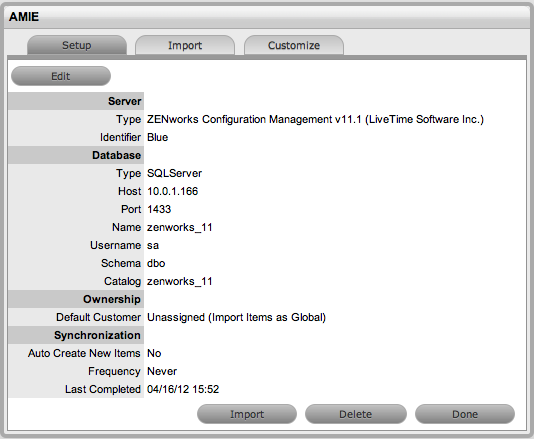
To delete the server configuration within AMIE and related snapshots:
-
Select Setup>AMIE>Setup
-
Select the Server link option within the AMIE list view
The expanded Setup screen is displayed with the Delete button.
-
Select the Delete button
A pop-up message is displayed asking your to confirm the deletion action.

-
Click OK.
A warning message is displayed informing you to restart the application server to complete the deletion process.

Re-enabling Deleted Items
To re-enable Deleted Items, initiate an Item search on deleted Items within the Configuration>Items screen of the Supervisor view.
Within the Supervisor view to search for a deleted Item:
-
Select Configuration>Items
-
Click the Search button
A simple search page will be displayed
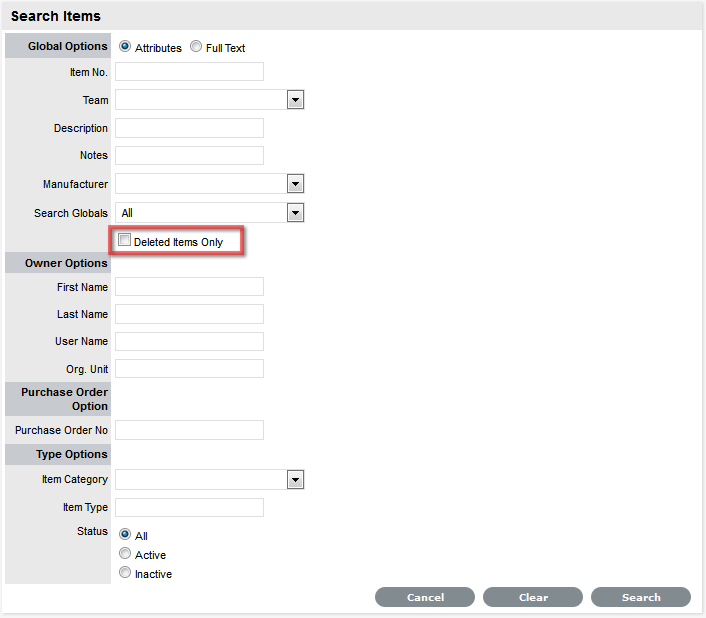
-
Enter a search term
-
Select the Deleted Item Only option
-
Click Search
A list of Items is displayed.
-
For the Item to be re-enabled, select the Item ID#
-
Click
 .
.
NOTE:Service desk now uses service name of the Oracle database configured with ZENworks. While using the Oracle database, if you are unable to connect to ZENworks, see ZENworks Core Admin for the service name.
Importing Items using a .CSV File
To import Items using a .CSV file, a .CSV template, containing all available fields, can be downloaded and populated. The service management system uses a field mapping Wizard to match fields in the template to those in the system. To download the template go to Setup > Item Import > Import. See Downloading an Item .CSV Template for more information on configuring the .CSV file.
Before Importing a CSV File
For an Item to be successfully imported, the following fields must be mapped:
-
Team/s
-
Status.
The Teams within the .CSV file must be created in the system before they can be associated with an Item as part of a .CSV import. Teams are created by a Supervisor under the User>Teams tab.
Items are imported based on Category (i.e. Hardware, Software, etc.), which must be configured by the Supervisor within the Configuration>Categories tab before conducting a .CSV import. The Categories configuration defines the Details recorded in the Item to be imported into the system. The Administrator must create separate .CSV files based on the Categories configured, that are then individually uploaded into the application.
For Items imported with owners, the Username in the .CSV file must match the Username within the support system. If the owner does not exist in the system, the imported Item will become a Global Item.
NOTE:If relationships are to be created between Items upon import, Parent Items should be imported first. If the system generated Item Number is to be used for the Parent Item, it needs to be included in the Parent Item Number field of the Related Items when they are imported.
Importing Items
To import a CSV File using the Import Wizard:
-
Select Setup>AMIE
-
Select the Import tab
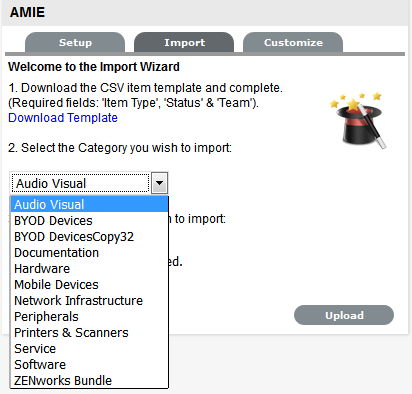
To access a template that illustrates the fields the application maps and the data types (see below), click the Download Template link on the Item Import Wizard screen within the Setup>AMIE>Import tab.
The following fields should be visible:
Item Number(Unique char 64),Item Type(char 128),Manufacturer(char 128),Incident Team(char 64),Problem Team(char 64),Change Team(char 64),Request Team(char 64), Company(char 128),Department(char 128),Room(char 64),Username (char 64),Status(char 128),Criticality(char 64)Purchase Date(datetime),Cost(decimal),Field1(char 256),Field2(char 256),Field3(char 256),Field4(char 256),Field5(char 256),Field6(char 256),Field7(char 256),Field8(char 256),Field9(char 256), Field10(char 256),Field11(char 256),Field12(char 256),Field13(char 256),Field14(char 256),Field15(char 256),Field16(char 256),Field17(char 256),Field18(char 256),Field19(char 256),Field20(char 256),Notes(CLOB),Relationship Name(char 256),Parent Item Number(char 64)
The char ### designation in parentheses after each field name signifies what type of data the import utility expects to see in each field. For instance:
-
Item Type (char 128) means that the first name field cannot exceed 128 characters.
-
Fields marked as Unique must be unique in the system.
-
Note the Room details MUST be in the following format: COMPANY-DEPARTMENT;Room
When creating a .CSV file for a Category, to determine the Field number of a configured Custom Field, within theCategory tab of an Item Category select the System defined Ordering option. The field labels will then be listed in sequential order from one to twenty.
-
-
To import, select the Item Category
The drop-down list consists of all Categories created by the Supervisor in Configuration>Categories.
-
Enter the file location, or use the Browse button
-
Select Upload
The Field Mapping Wizard appears. Fields that can be mapped to the CSV file are available in the drop-down list.
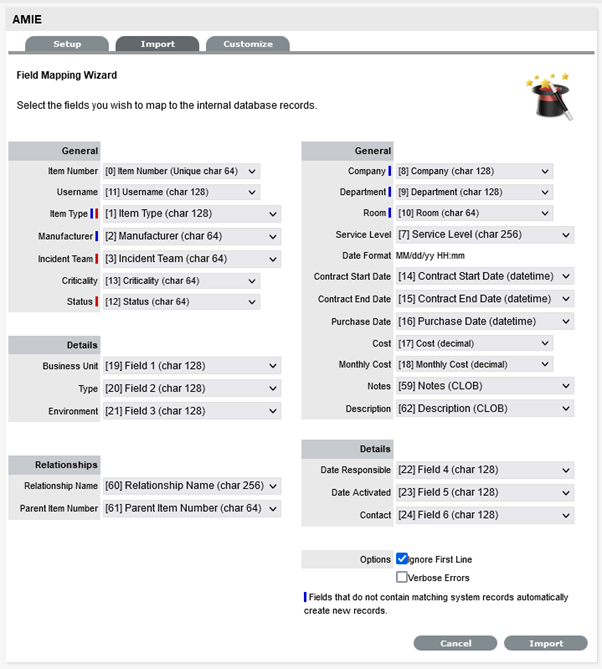
-
Review and map the fields within the .CSV
Field Mapping Wizard
General
Item Number
Unique Item number of the Configuration Item, this can be generated by the system or defined in the .CSV file.
Username
Customer owning the Configuration Item, imported by entering their user name.
Item Type II
Item Type of the Configuration Item.
Manufacturer I
Sets the manufacturer details of the Item.
Incident Team I
Incident Team assigned to the Configuration Item.
Problem Team I
Problem Team assigned to the Configuration Item.
Change Team I
Change Team assigned to the Configuration Item.
Request Team I
Request Team assigned to the Configuration Item
Criticality
Sets the default Criticality (i.e, critical, high, moderate, low, very low) for the Item. Optional.
Status I
Default Configuration Item Status.
Company I
Company owning the Configuration Item.
Department I
Department owning the Configuration Item.
Room I
The location of the Item. The .csv file data format to import this information MUST be:
COMPANY-DEPARTMENT;Room
Service Level
Configuration Item assigned SLA.
Date Format
Displays the date format required for the contract details to be imported successfully.
Contract Start Date
Sets the start date of a contract associated with an Item.
Contract End Date
Sets the end date of a contract associated with an Item.
Purchase Date
Date the Item was purchased.
Cost
The cost of the Item.
Monthly Cost
Sets the monthly Service Cost on per month basis for the Item.
Notes
Free text to add notes to the Item. Optional.
Details
Fields 1 to 20
Custom fields created for the Category are displayed and can be mapped to the Item based on information included in the .CSV file.
Relationships
Relationship Name
Defines the description of the relationship between the Item set in the following field.
Parent Item Number
Identifies the Item with which an Item is related using the Item Number.
Options
Ignore First Line
Option to ignore first row upon import.
Verbose Errors
Detailed description of any errors that occur during the import process.
I = Information that needs to exist in the system before the import
I = Fields that are mandatory
NOTE:If relationships are to be created between Items upon import, Parent Items should be imported first. If the system generated Item Number is to be used for the Parent Item, it needs to be included in the Parent Item Number field of the Related Items when they are imported.

-
Select the Ignore First Line checkbox if the first line of the imported CSV file has field headings
Leave the checkbox clear if the CSV file begins with usable data.
-
Click Verbose Errors to record a detailed description of any errors that occur during the import
Leaving the box unchecked will return a summarized error report.
-
Select Import to bring into the system the mapped field data
The Item Import screen displays the results of the import.
-
Select Done.
Configuring Items after the Import
During the Item Import, elements that do not exist in the database are created. These are the fields marked with a blue line within the Field Mapping Wizard:
-
Item Type
-
Warranty
-
Organizational Units
After an import, all Item Types that have been created will need to be further configured.
To complete Item Type configuration:
-
Log in to the Supervisor Portal
-
Select Configuration>Types
-
In the Item Types screen, click on the newly created Item
The Type Information screen appears.
-
Complete the following fields:
Item Type
Name
Name of the Item Type.
Manufacturer
The manufacturer of the Item Type. New manufacturers can be created and existing manufacturers can be edited and deleted by using the Edit and New buttons that appear beside the drop-down menu of manufacturers.
Item Category
This signifies the type of Item. (Hardware, Software or Service are the default Types, but Users with the Supervisor Role can create more if required).
Identifier
The drop-down list that appears is drawn from the fields defined for the Item Category selected. Although this information is not required, the Identifier is used to differentiate similar Items that may be in use throughout an organization. For example, if an organization uses the same printers for all departments, an Item Category field of "Location" could be configured for the Item Details and this could also be used as a secondary Identifier for Printer Item.
Criticality
Rates the degree of importance of an Item Type within an organization, which can be adjusted on a per Item basis. The 'Impact' of a Request is initially pulled from the Criticality of the Item, but can be adjusted within the request Information screen if required. Requests logged through the Customer Portal, use the Criticality of the Item to set the Priority of the request.
The Incident Analyzer, if enabled by the Administrator in Setup>CMS>Incident Analyzer, can apply the Criticality to automatically detect Problems.
The minimum Criticality level can also be used to determine the off-line Items that appear on Outages pages, if the Outages pages are enabled by the Administrator in Setup>Privileges>System.
Icon
When the Type details are saved, the Icon selected for the Item Category will be displayed. To customize the icon for the specific Item Type, select the Icon to access the Upload
 or Cancel
or Cancel  options.
options.Unit Price
The per-unit price of the Item Type.
Instance Total
Number of instances owned by the organization.
Assigned
Number of instances assigned to Customers as Items.
Hidden
Select 'On' to ensure Customers cannot view this Item Type within the list in the Customer Portal. If all Item Types use this selection, the Item Type list will be completely removed from the Portal.
Items created using Item Types with Hidden enabled, will not allow Customers to generate requests against them in the Customer Portal, nor will they be able to view or receive updates about requests logged by the User against Items with this functionality enabled.
Creation
Enabling this option gives Customers using the portal the ability to create new Items using this Item Type (if they have been granted the ability to create Items by the Administrator in Setup>Privileges>Customer>Create Item. (This option is not displayed when the Hidden option is enabled.)
Ignore Share
Enabling this option overrides the system level option for sharing requests raised against Items of this Type. Requests raised against Items of this Type will not appear in the customer portal when viewing shared requests is enabled.
Add Forum Topic
Create a forum topic using the Item Type Name. This option is only displayed when a new Type is being created.
Incident Default
The Team of Technicians assigned to support Incidents received related to the Item Type. See: Teams
Problem Default
The Team of Technicians assigned to support Problems received related to the Item Type. See: Teams
Change Default
The Team of Technicians assigned to support Change Requests received related to the Item Type. See: Teams
Request Default
The Team of Technicians assigned to support Service Requests received related to the Item Type. See: Teams
Service Level Default
The default service level for the Item Type. When Billing is enabled, service levels without a cost are listed as an option. The service level with an associated cost can be applied when the Item created, this ensures Item contract payment is processed.
Support Levels
All Service Level Agreements assigned to the Item Type, which will be displayed as options when a request is created applying Item that uses this Type template. SLAs listed here, are used within the Costs tab of Service Types to forecast break even points on the Service relative to the number of Users.
Find SLA (Name)
To assign multiple SLAs use this option. Click
 to view all SLAs or refine the search by entering a specific name. Select the SLA hyperlink to assign the SLA to the Type Information. Click
to view all SLAs or refine the search by entering a specific name. Select the SLA hyperlink to assign the SLA to the Type Information. Click  to clear the search field.
to clear the search field. -
Enter the Unit Price for the Item Type. This is an optional field that is used for asset management
See Finance Role.
-
Set the Customer options
-
Assign the default support Teams
-
Assign one or multiple SLAs, as required
-
Click Save
-
Move to the Classification tab to create problem classification for this Item Type.
Click on the Item Type name to continue configuration.
Assigning multiple Companies and Departments to an Item
The .CSV file import facility can also be used to assign more than one Company and Department to an Item, if required. To assign multiple companies within the Company column of the .CSV file, enter the company names separated by a semi-colon (;) If the Company or Companies do not exist in the system, or have been deleted, a new Company will be created.
When importing multiple Departments related to the multiple Companies, the Department related to the Company must be listed in the same order as the Companies and separated by a semi-colon. For example:
Company Field: comp1;comp2
Department Field: dept1:depart2 or ;dept2 or dept1;
Any departments that do not exist in the database or have been deleted, will be created as a result of the .CSV import.
To assign rooms to one of the locations of this multiple Company/Department assignment, the full details of the Company and Department must be entered into the column followed by a semi-colon and the Room number. An example of the Room import format is:
Company Field:CompName1;CompName2
Department Field:Dept1;Dept2
Room Field: CompName1 - Dept1;Room1
Updating Item Information via .CSV
To easily update multiple Items that already exist within system, information can be imported using a .CSV file. For the update to be successful, the Item number in the .CSV file must match the Item number in the system.
Follow the above Importing Items procedure and ensure the Item Number field is mapped correctly. If an Item Number is not included in the .CSV file, a new Item will be created.
Downloading an Item .CSV Template
Downloading an Item .CSV Template
To download and populate the CSV Template for the CMDB Item Import process:
-
Select Setup>AMIE
-
Select the Import tab

To view a template that illustrates the fields the application is looking for and the data types (see below), click the Download Template link on the Item Import Wizard screen within Import tab of Item Import in the Setup tab.
The following fields should be visible:
Item Number(Unique char 64),Item Type(char 128),Manufacturer(char 128),Incident Team(char 64),Problem Team(char 64),Change Team(char 64),Request Team(char 64), Company(char 128),Department(char 128),Room(char 64),Username (char 64),Status(char 128),Criticality(char 64)Purchase Date(datetime),Cost(decimal),Field1(char 256),Field2(char 256),Field3(char 256),Field4(char 256),Field5(char 256),Field6(char 256),Field7(char 256),Field8(char 256),Field9(char 256), Field10(char 256),Field11(char 256),Field12(char 256),Field13(char 256),Field14(char 256),Field15(char 256),Field16(char 256),Field17(char 256),Field18(char 256),Field19(char 256),Field20(char 256),Notes(CLOB),Relationship Name(char 256),Parent Item Number(char 64)
The char ### designation in parentheses after each field name signifies what type
of data the import utility expects to see in each field. For instance:
-
-
Item Type (char 128) means that the first name field cannot exceed 128 characters.
-
Fields marked as Unique must be unique in the system.
-
Note the Room details MUST be in the following format: COMPANY-DEPARTMENT;Room
-
-
-
To import, select the Item Category
The drop-down list consists of all Categories created by the Supervisor in Configuration>Categories.
-
Enter the file location, or use the Browse button
-
Select Upload
The Field Mapping Wizard appears. Fields that can be mapped to the CSV file are available in the drop-down list.

-
Review and map the fields within the .CSV
Field Mapping Wizard
General
Item Number
Unique Item number of the Configuration Item, this can be generated by the system or defined in the .CSV file.
Username
Customer owning the Configuration Item, imported by entering their user name.
Item Type II
Item Type of the Configuration Item.
Manufacturer I
Sets the manufacturer details of the Item.
Incident Team I
Incident Team assigned to the Configuration Item.
Problem Team I
Problem Team assigned to the Configuration Item.
Change Team I
Change Team assigned to the Configuration Item.
Request Team I
Request Team assigned to the Configuration Item
Criticality
Sets the default Criticality (i.e, critical, high, moderate, low, very low) for the Item. Optional.
Status I
Default Configuration Item Status.
Company I
Company owning the Configuration Item.
Department I
Department owning the Configuration Item.
Room I
The location of the Item. The .csv file data format to import this information MUST be:
COMPANY-DEPARTMENT;Room
Service Level
Configuration Item assigned SLA.
Date Format
Displays the date format required for the contract details to be imported successfully.
Contract Start Date
Sets the start date of a contract associated with an Item.
Contract End Date
Sets the end date of a contract associated with an Item.
Purchase Date
Date the Item was purchased.
Cost
The cost of the Item.
Monthly Cost
Sets the monthly Service Cost on per month basis for the Item.
Notes
Free text to add notes to the Item. Optional.
Details
Fields 1 to 20
Custom fields created for the Category are displayed and can be mapped to the Item based on information included in the .CSV file.
Relationships
Relationship Name
Defines the description of the relationship between the Item set in the following field.
Parent Item Number
Identifies the Item with which an Item is related using the Item Number.
Options
Ignore First Line
Option to ignore first row upon import.
Verbose Errors
Detailed description of any errors that occur during the import process.
I = Information that needs to exist in the system before the import
I = Fields that are mandatory
NOTE:If relationships are to be created between Items upon import, Parent Items should be imported first. If the system generated Item Number is to be used for the Parent Item, it needs to be included in the Parent Item Number field of the Related Items when they are imported.

-
Select the Ignore First Line checkbox if the first line of the imported CSV file has field headings. Leave the checkbox clear if the CSV file begins with usable data.
-
Click in Verbose Errors for detailed descriptions of any errors that may occur during the import
Leaving the box unchecked will return abbreviated errors.
-
Select Import to bring into the system the mapped field data
The Item Import screen displays the results of the import.
-
Select Done.
Configuring Items after the Import
During the Item Import, elements that do not exist in the database are created. These are the fields marked with a blue line within the Field Mapping Wizard:
-
Item Type
-
Warranty
-
Organizational Units
After an import, all Item Types that have been created will need to be further configured.
To complete Item Type configuration:
-
Log in to the Supervisor Portal
-
Select Configuration>Types
-
In the Item Types screen, click on the newly created Item
The Type Information screen appears.
-
Complete the following fields:
Item Type
Name
Name of the Item Type.
Manufacturer
The manufacturer of the Item Type. New manufacturers can be created and existing manufacturers can be edited and deleted by using the Edit and New buttons that appear beside the drop-down menu of manufacturers.
Item Category
This signifies the type of Item. (Hardware, Software or Service are the default Types, but Users with the Supervisor Role can create more if required).
Identifier
The drop-down list that appears is drawn from the fields defined for the Item Category selected. Although this information is not required, the Identifier is used to differentiate similar Items that may be in use throughout an organization. For example, if an organization uses the same printers for all departments, an Item Category field of "Location" could be configured for the Item Details and this could also be used as a secondary Identifier for Printer Item.
Criticality
Rates the degree of importance of an Item Type within an organization, which can be adjusted on a per Item basis. The 'Impact' of a Request is initially pulled from the Criticality of the Item, but can be adjusted within the request Information screen if required. Requests logged through the Customer Portal, use the Criticality of the Item to set the Priority of the request.
The Incident Analyzer, if enabled by the Administrator in Setup>CMS>Incident Analyzer, can apply the Criticality to automatically detect Problems.
The minimum Criticality level can also be used to determine the off-line Items that appear on Outages pages, if the Outages pages are enabled by the Administrator in Setup>Privileges>System.
Icon
When the Type details are saved, the Icon selected for the Item Category will be displayed. To customize the icon for the specific Item Type, select the Icon to access the Upload
 or Cancel
or Cancel  options.
options.Unit Price
The per-unit price of the Item Type.
Instance Total
Number of instances owned by the organization.
Assigned
Number of instances assigned to Customers as Items.
Hidden
Select 'On' to ensure Customers cannot view this Item Type within the list in the Customer Portal. If all Item Types use this selection, the Item Type list will be completely removed from the Portal.
Items created using Item Types with Hidden enabled, will not allow Customers to generate requests against them in the Customer Portal, nor will they be able to view or receive updates about requests logged by the User against Items with this functionality enabled.
Creation
Enabling this option gives Customers using the portal the ability to create new Items using this Item Type (if they have been granted the ability to create Items by the Administrator in Setup>Privileges>Customer>Create Item. (This option is not displayed when the Hidden option is enabled.)
Ignore Share
Enabling this option overrides the system level option for sharing requests raised against Items of this Type. Requests raised against Items of this Type will not appear in the customer portal when viewing shared requests is enabled.
Add Forum Topic
Create a forum topic using the Item Type Name. This option is only displayed when a new Type is being created.
Incident Default
The Team of Technicians assigned to support Incidents received related to the Item Type. See: Teams
Problem Default
The Team of Technicians assigned to support Problems received related to the Item Type. See: Teams
Change Default
The Team of Technicians assigned to support Change Requests received related to the Item Type. See: Teams
Request Default
The Team of Technicians assigned to support Service Requests received related to the Item Type. See: Teams
Service Level Default
The default service level for the Item Type. When Billing is enabled, service levels without a cost are listed as an option. The service level with an associated cost can be applied when the Item created, this ensures Item contract payment is processed.
Support Levels
All Service Level Agreements assigned to the Item Type, which will be displayed as options when a request is created applying Item that uses this Type template. SLAs listed here, are used within the Costs tab of Service Types to forecast break even points on the Service relative to the number of Users.
Find SLA (Name)
To assign multiple SLAs use this option. Click
 to view all SLAs or refine the search by entering a specific name. Select the SLA hyperlink to assign the SLA to the Type Information. Click
to view all SLAs or refine the search by entering a specific name. Select the SLA hyperlink to assign the SLA to the Type Information. Click  to clear the search field.
to clear the search field. -
Enter the Unit Price for the Item Type. This is an optional field that is used for asset management
See Finance Role.
-
Set the Customer options
-
Assign the default support Teams
-
Assign one or multiple SLAs, as required
-
Click Save
-
Move to the Classification tab to create problem classification for this Item Type.
Click on the Item Type name to continue configuration.
Assigning multiple Companies and Departments to an Item
The .CSV file import facility can also be used to assign more than one Company and Department to an Item, if required. To assign multiple companies within the Company column of the .CSV file, enter the company names separated by a semi-colon (;) If the Company or Companies do not exist in the system, or have been deleted, a new Company will be created.
When importing multiple Departments related to the multiple Companies, the Department related to the Company must be listed in the same order as the Companies and separated by a semi-colon. For example:
Company Field: comp1;comp2
Department Field: dept1:depart2 or ;dept2 or dept1;
Any departments that do not exist in the database or have been deleted, will be created as a result of the .CSV import.
To assign rooms to one of the locations of this multiple Company/Department assignment, the full details of the Company and Department must be entered into the column followed by a semi-colon and the Room number. An example of the Room import format is:
Company Field:CompName1;CompName2
Department Field:Dept1;Dept2
Room Field: CompName1 - Dept1;Room1
Updating Item Information via .CSV
To easily update multiple Items that already exist within system, information can be imported using a .CSV file. For the update to be successful, the Item number in the .CSV file must match the Item number in the system.
Follow the above Importing Items procedure and ensure the Item Number field is mapped correctly. If an Item Number is not included in the .CSV file, a new Item will be created.